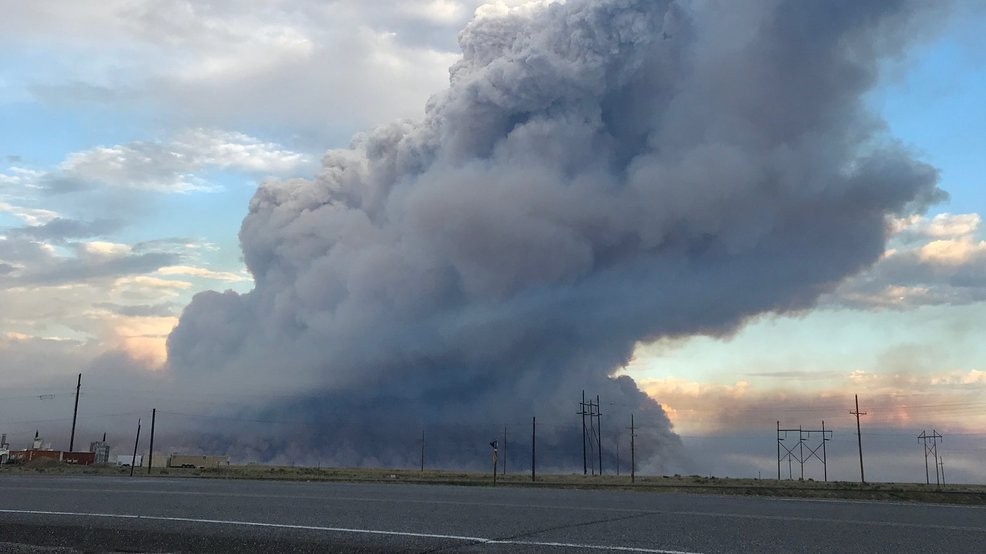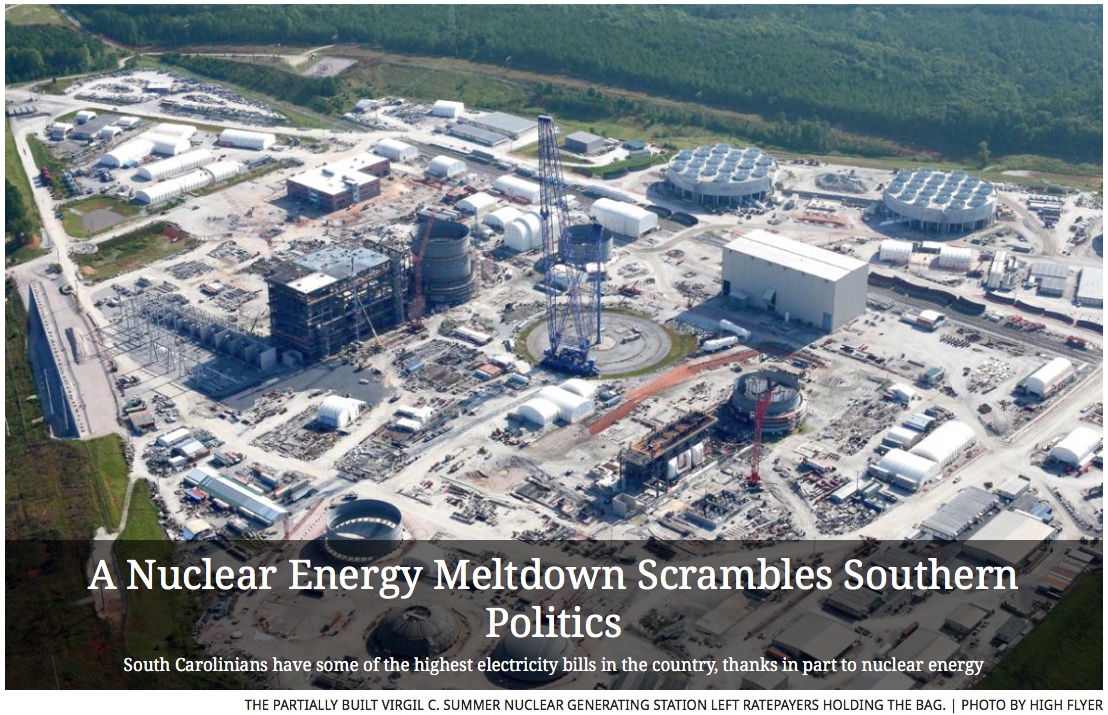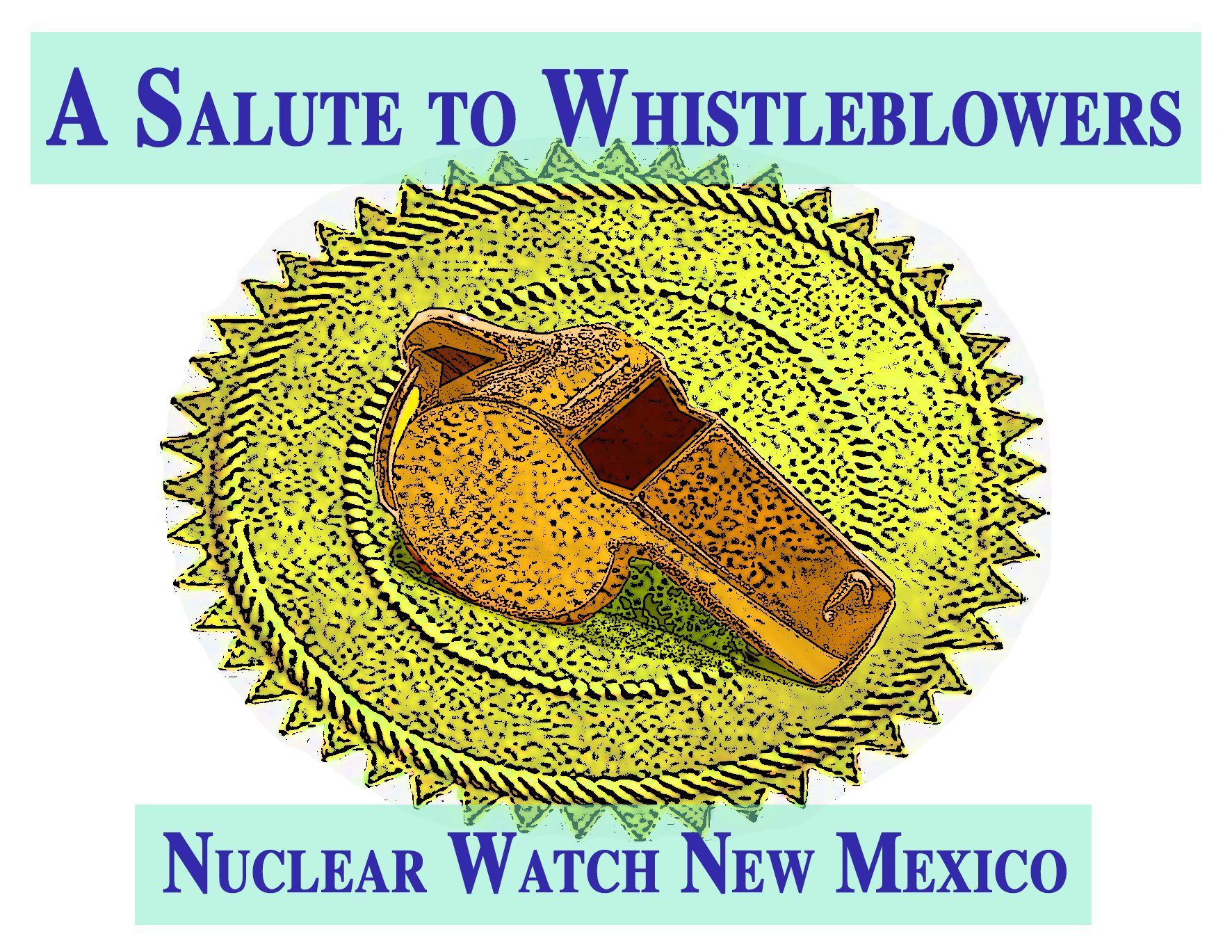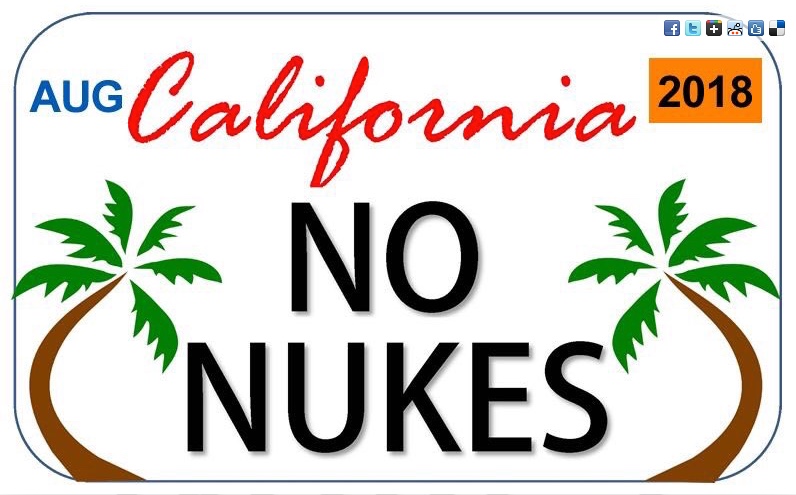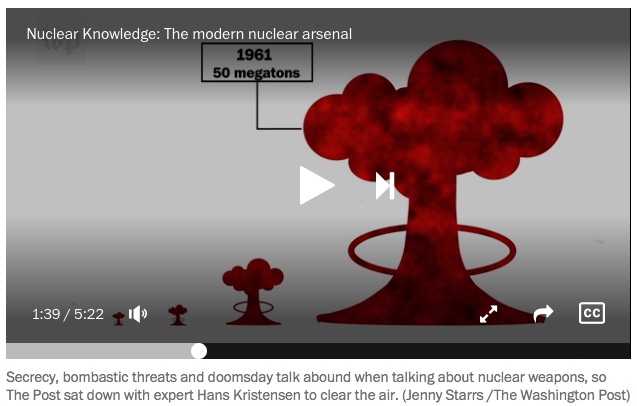Nuclear News Archives – 2020
Smith and Menendez Statement on the Immense Costs of Allowing the New START Treaty to Expire
Already exorbitant nuclear weapons costs will only go up if the New START treaty expires.
“Extending the New START Treaty for a full five years is clearly the right financial and national security choice. America cannot afford a costly and dangerous nuclear arms race, particularly in the middle of our current economic, political, and health crises.”
FOR IMMEDIATE RELEASE: August 26, 2020
Contact:
Smith: Monica Matoush // 202-226-5048
Menendez: Juan Pachon // 202-224-4130
WASHINGTON, D.C. – Representative Adam Smith (D-Wash.), Chairman of the House Armed Services Committee, and Senator Bob Menendez (D-NJ), Ranking Member of the Senate Foreign Relations Committee, today issued the following statement after the Congressional Budget Office (CBO) published a new report regarding the potential costs of expanding U.S. strategic nuclear forces if the New Strategic Arms Reduction Treaty (New START) Expires:
“CBO’s nonpartisan report is clear: The Trump administration’s unwillingness to continue the decades of strategic arms control by failing to extend the New START Treaty is driving the United States toward a dangerous arms race, which we cannot afford. While this report only begins to account for the costs of the Administration’s preposterous claims that we can ‘spend the adversary into oblivion,’ it is further proof of why New START is essential to U.S. and international security.
Catholics Against Nukes: Archbishop Wester’s Hiroshima Vigil
As long as nuclear deterrence, that most unmeasured of strategies, remains, it keeps company with the prospect of use and annihilation. Coghlan, in his rebuke to the editors also penned in the Albuquerque Journal, gave an acid summation: “the US arsenal has always been about nuclear war fighting, starting with the simple fact that we were the first to use it.” Only “sheer luck has kept us from nuclear catastrophe.”
BY: Binoy Kampmark | scoop.com/nz
In what is a turn-up for the books, a senior voice of the Catholic Church made something of an impression this month that did not incite scandal, hot rage, or the commencement of an investigation. It did, however, agitate a few editors. Archbishop John C. Wester of San Fe, in speaking at the online Hiroshima Day vigil, had put up his hand to defy the validity and morality of nuclear weapons and, along with them, the idea of nuclear deterrence. One of the organisers of the event, the veteran peace activist Rev. John Dear, claimed it had “never happened before.”
Dear had a point. There has been a shift within Catholic ranks urged along by Pope Francis on that most fatuous of strategic doctrines, nuclear deterrence. Before the United Nations General Assembly in June 1982, Pope John Paul II chose to argue that nuclear “‘deterrence’ based on balance, certainly not as an end in itself but as a step on the way toward a progressive disarmament, may still be judged morally acceptable.”
America’s Ageing Nuclear Fleet Underprepared For Climate Change
Last year, Bloomberg conducted a review of “correspondence between the commission and owners of 60 plants” and made some terrifying discoveries. According to their own risk assessments, “54 of their [60] facilities weren’t designed to handle the flood risk they now face.”
By: Haley Zaremba / oilprice.com
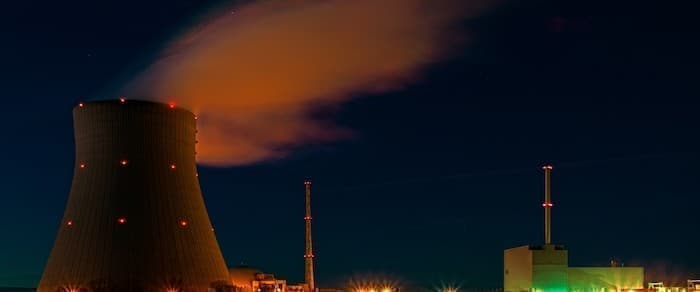
The United States is not only one of the first and foremost nuclear powers of the world, it has also long been the nuclear powerhouse of the planet, being responsible for a whopping two thirds of global nuclear energy production. Domestically, the United States’ nuclear power plants account for approximately 20 percent of the nation’s total electricity and produce over 50 percent of the entire country’s carbon-free energy generation. But these superlatives, both global and domestic, won’t last. As nuclear energy grows around the world, the industry is in deep trouble in the U.S., where the aging nuclear fleet has been battered by a flood of cheap shale oil and natural gas, and is now barely clinging to life thanks to hefty government subsidies and leaving the shockingly high cost of radioactive waste maintenance to the taxpayers.
New Video Shows Largest Hydrogen Bomb Ever Exploded
A Russian nuclear energy agency released formerly classified footage of the Soviet Union’s 1961 Tsar Bomba test.
BY: William J. Broad | nytimes.com
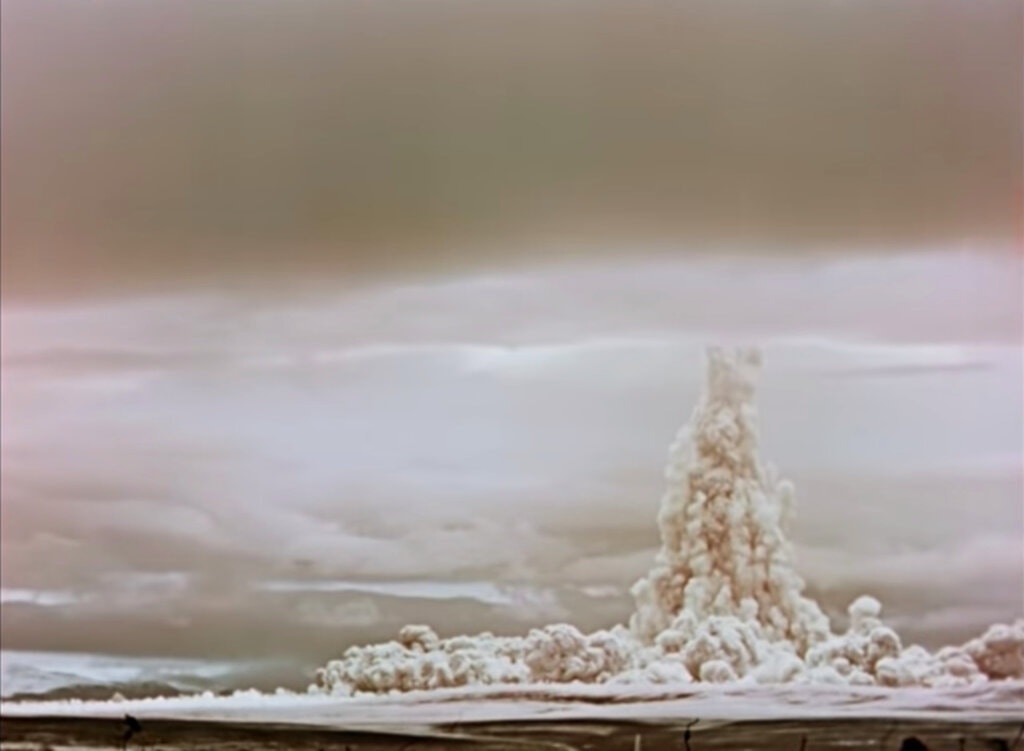
Hydrogen bombs — the world’s deadliest weapons — have no theoretical size limit. The more fuel, the bigger the explosion. When the United States in 1952 detonated the world’s first, its destructive force was 700 times as great as that of the atomic bomb that destroyed Hiroshima.
And in the darkest days of the Cold War, the Soviets and the Americans didn’t only compete to build the most weapons. They each sought at times to build the biggest bomb of all.
Russia Releases “Tsar Bomba” Test Footage Of The Most Powerful Nuclear Bomb Blast Ever
This previously classified film provides a new and fascinating glimpse into the 50-megaton Cold War nuclear test that occurred nearly six decades ago.
Don’t Preach Nuclear Arms to Archbishop
“That $2 trillion nuclear weapons modernization will do nothing to protect us against the global pandemic impacting Americans now. Further, the Sandia and Los Alamos labs may actually degrade national security with planned new nuclear weapons designs that can’t be tested because of the global testing moratorium. Or worse yet, this may prompt the U.S. back into testing, throwing more gas on the fire of the new nuclear arms race.”
BY: JAY COGHLAN / NUCLEAR WATCH NEW MEXICO, SANTA FE
Monday, August 24th, 2020 at 12:02am
 In response to (the Aug. 13) editorial “Archbishop’s nuclear weapons view needs a homily on reality,” I was one of the speakers at the 75th anniversary commemoration of the Hiroshima atomic bombing, organized by Fr. John Dear, at which Santa Fe Archbishop John Wester eloquently spoke. The editorial declared “neither Wester nor Dear appear to accept the premise there is any deterrent benefit to the nuclear arsenal.”
In response to (the Aug. 13) editorial “Archbishop’s nuclear weapons view needs a homily on reality,” I was one of the speakers at the 75th anniversary commemoration of the Hiroshima atomic bombing, organized by Fr. John Dear, at which Santa Fe Archbishop John Wester eloquently spoke. The editorial declared “neither Wester nor Dear appear to accept the premise there is any deterrent benefit to the nuclear arsenal.”
To the contrary, the Journal perpetuates the delusion that the U.S. nuclear arsenal is just for deterrence, a premise fed to American taxpayers since the beginning of the Cold War. Instead, the U.S. arsenal has always been about nuclear warfighting, starting with the simple fact that we were the first to use it. This continues to this day, as the Pentagon made clear in a 2013 nuclear policy declaration: “The new guidance requires the United States to maintain significant counterforce capabilities against potential adversaries. The new guidance does not rely on a ‘counter-value’ or ‘minimum deterrence’ strategy.”
NOTE: This study has notable implications since the New Mexico congressional delegation touts expanded nuclear weapons programs as an economic engine for northern New Mexico.
Study: Neighboring counties lose money due to LANL
BY: KYLE LAND Copyright © 2020 Albuquerque Journal
SANTA FE — A study conducted by University of New Mexico researchers found that Los Alamos National Laboratory has a negative economic impact on nearby communities, despite employing many people in the area.
Of the seven counties included in the study, governments in six of them were found to be losing money due to LANL’s impact, with the exception of Los Alamos. Those counties include Santa Fe, Rio Arriba, Sandoval, San Miguel, Taos and Mora.
The study, conducted by UNM’s Bureau of Business and Economic Research, found Los Alamos County gained $13 million from economic activity created by the lab, while all other counties lost an average of $1.25 million.
Santa Fe and Rio Arriba counties, home to 40% of the Lab’s employees, had the largest losses, at more than $2 million.
In a Friday presentation of the findings to the Regional Coalition of LANL Communities, Bureau Director Jeff Mitchell said his team calculated how much revenue LANL employees produce for an area versus what it costs a local government to provide services for them.
The study, Mitchell said, found that LANL and its employees tend to spend their money in only a few places.
Thirty-eight percent of the Lab’s spending actually goes to Bernalillo County, with another 42% staying within Los Alamos County, according to the study.
Trump Administration Sends Mixed Signals on Nuclear Weapons Budgeting
“A Senate-passed proposal would grant the Nuclear Weapons Council new authority to edit NNSA’s budget request after the Energy Department crafts it and before the request is submitted to the White House budget office.”
BY:Joe Gould & Aaron Mehta
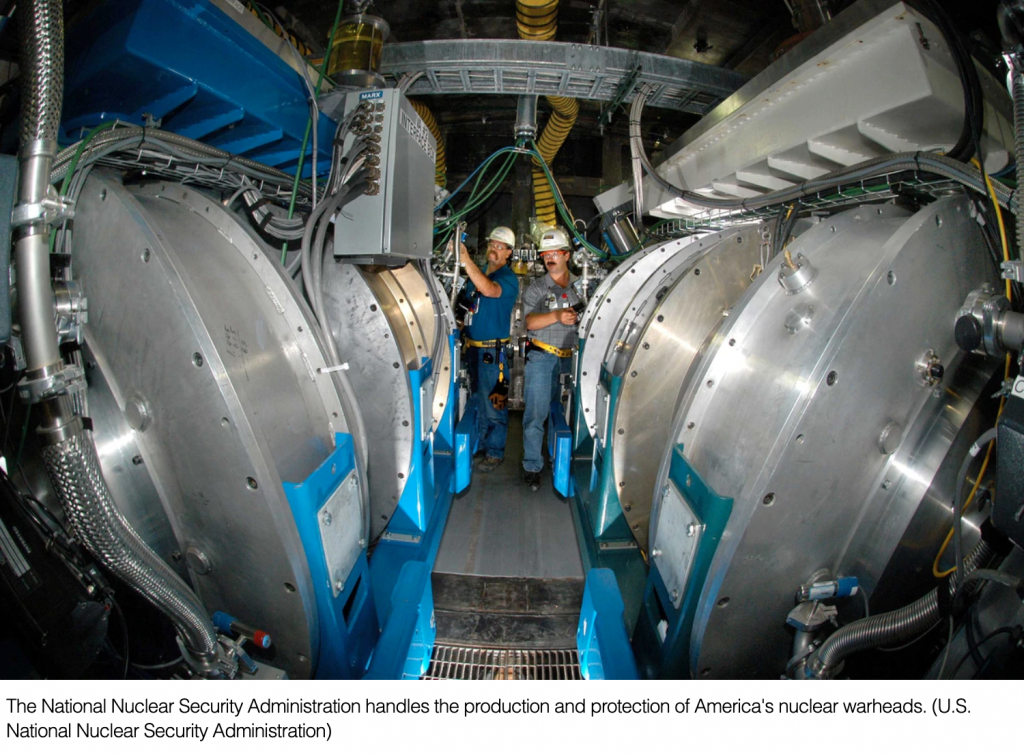
WASHINGTON ― Defense hawks in Congress are pushing a contentious plan to give the Pentagon a stronger hand in crafting nuclear weapons budgets, but the Trump administration has been sending mixed messaging over recent weeks about whether the change is needed.
The Senate-passed version of the annual defense policy bill would give the Pentagon-led Nuclear Weapons Council a say in the budget development of the National Nuclear Security Administration, a semi-autonomous agency within the Department of Energy that’s responsible for the stockpile’s safety, security, and effectiveness.
NOTE: This article is illustrative of the absolutely key role New Mexico plays in the new nuclear arms race, far beyond just the Los Alamos and Sandia Labs. The Air Force Nuclear Weapons Center is on Kirtland Air Force Base which shares runways with the Albuquerque, NM airport. The new nuclear arms race will be increasingly dangerous with likely hypersonic and cyber weapons.
US Air Force May Have Accidentally Revealed Interest in Hypersonic Nuke
BY: Valerie Insinna
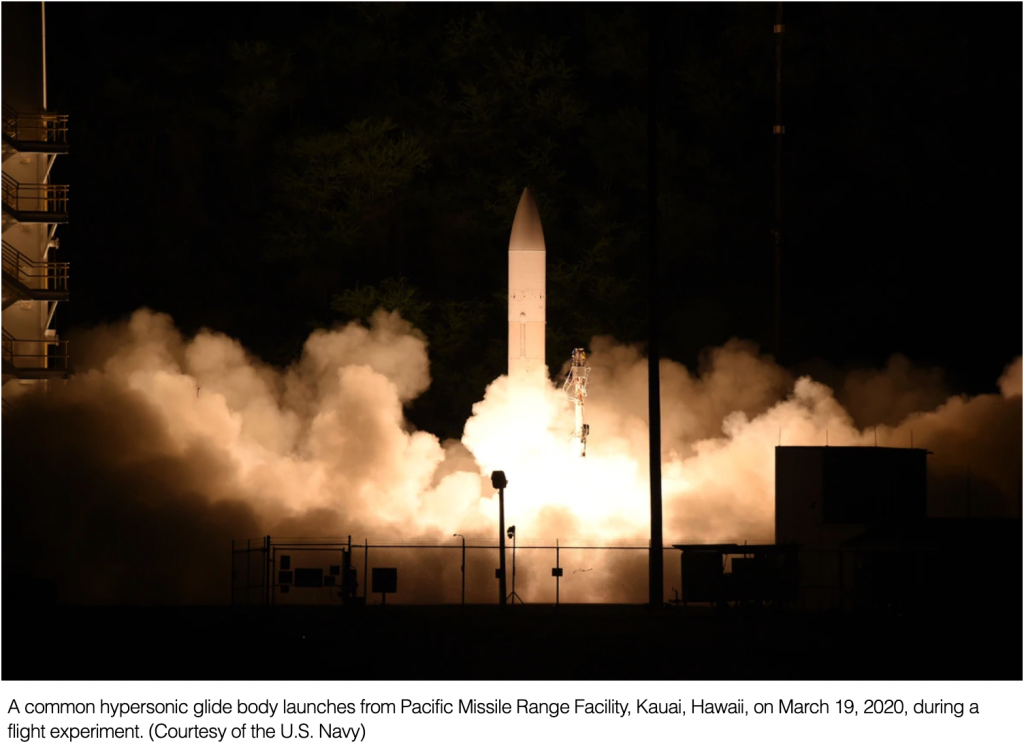
WASHINGTON — The U.S. Air Force has issued, and quietly revoked, a solicitation to industry seeking technologies that would support a hypersonic glide vehicle capable of traversing intercontinental ranges, potentially signaling the military’s interest in a hypersonic nuclear weapon.
According to an Aug. 12 request for information first reported by Aviation Week, the Air Force Nuclear Weapons Center sought ideas for potential upgrades to intercontinental ballistic missiles, including a “thermal protection system that can support [a] hypersonic glide to ICBM ranges.”
USAF Rethinks Relationship Between Conventional, Nuclear Weapons
“What we’re trying to prepare ourselves to do is to respond with whatever force is necessary in a nuclear environment. It’s not so much to fight tactically. Really, the ultimate goal here is to deter. We want to raise that threshold of using nuclear weapons, whether strategic or non-strategic … to the highest level possible.”
To do that, Clark argues the Air Force needs ways to stop others from using nuclear weapons in the first place, and options to retaliate if deterrence fails. Technology, training, and command-and-control requirements all need to be updated to support that approach.
BY: Rachel S. Cohen
The Air Force is crafting new policy that envisions more fluidity between conventional and nuclear weapons, as well as a broader range of options to keep others from using their own nuclear weapons.
The U.S. has long treated conventional and nuclear warfare as separate concepts, but that’s beginning to change, said Lt. Gen. Richard M. Clark, the Air Force’s deputy chief of staff for strategic deterrence and nuclear integration.
DOE Issues Draft RFP for the Oak Ridge Reservation Cleanup Contract
Cincinnati – Today, the U.S. Department of Energy’s Office of Environmental Management (EM) issued a Draft Request for Proposals for the Oak Ridge Reservation Cleanup Contract (ORRCC) procurement at the Oak Ridge Reservation (ORR), in Oak Ridge, Tennessee.
 Media Contact:
Media Contact:
Toni Rutherford
(513) 246-1374
Toni.Rutherford@emcbc.doe.gov
The purpose of the Draft RFP is to solicit input from interested parties to assist DOE in developing a Final RFP for this procurement. DOE invites all interested parties to thoroughly examine the Draft RFP and the accompanying procurement website in their entirety and to submit comments to DOE.
DOE anticipates an Indefinite-Delivery/Indefinite-Quantity (IDIQ) contract with a ten-year ordering period from which Firm-Fixed-Price and/or Cost-Reimbursement-type task orders may be issued, with an estimated contract ceiling of approximately $8.3 billion over the ordering period. It is anticipated that task order performance may extend up to five years beyond the end of the ordering period.
None of the Above Podcast
The Atomic Bomb’s First Victims – Beata Tsosie-Pena & Jay Coghlan on Downwinders
"There's this misconception that Hiroshima & Nagasaki were the first victims of the atomic bombing when really it was the people of New Mexico."
Our latest episode commemorates the #75thanniversary of the world's first nuclear attack.
Listen here: https://t.co/3YV9xPl3NV pic.twitter.com/JetubewTNJ
— Eurasia Group Foundation (@EGFound) August 18, 2020
REMEMBERING HIROSHIMA: This Hiroshima survivor returned to the site of the atomic bombing 75 years later.
Hiroshima to a Healthy Tomorrow: Embracing Our Common Humanity in a Virtual Rally
|
|
OREPA challenges NNSA’s “Final Supplement Analysis.”
The Oak Ridge Environmental Peace Alliance, along with Nuclear Watch New Mexico, has challenged the National Nuclear Security Administration’s latest justification for the Uranium Processing Facility bomb plant under construction at the Y-12 National Security Complex in Oak Ridge, Tennessee. In a letter to the Secretary of Energy and the Administrator of the NNSA, OREPA and NWNM pointed out that the Final Supplement Analysis, released in July, falls far short of the “hard look” required by the National Environmental Policy Act.
See OREPA Comments
The Final Supplement Analysis is NNSA’s attempt to comply with the order of the federal court in Knoxville, Tennessee. The court, in September of last year, ruled in favor of OREPA, NWNM, the Natural Resources Defense Council and four individual plaintiffs who argued that NNSA is in violation of NEPA, the law that requires federal agencies to consider the environmental impacts of their actions.
SEE ALSO:
[ILLINOIS] ComEd, Madigan Sued for $450M in Racketeering Suit
Illinois electric customers filed a federal civil racketeering lawsuit against ComEd and state House Speaker Michael Madigan, seeking more than $450 million in damages.
Breaking news update: Today, August 10, a putative class of Commonwealth Edison customers filed a civil racketeering lawsuit against Illinois Speaker of the House Michael Madigan, Commonwealth Edison Company (“ComEd”), ComEd’s parent Exelon Corporation, and several other defendants. Read all the details here.
BY: Michael Yoder | rtoinsider.com
The recent Illinois lobbying corruption scandal involving Exelon Corporation, its subsidiary Commonwealth Edison and Democratic House Speaker, Michael Madigan, demonstrates the extent to which nuclear “power” is about more than electrons.
The FBI arrests of the Ohio House Speaker and five others in a $60 million bribery/corruption scheme; the $10 billion Exelon nuclear bailout in New York; the questionable circumstances surrounding Exelon’s 2016 PepCo merger; and the South Carolina $9 billion SCANA fraud case, suggest that this may be a national pandemic.
DARK CIRCLE: The Sundance Grand Prize-winning classic doc about the dangers of the atomic age – newly restored!
Dark Circle – Official Trailer from First Run Features on Vimeo.
It’s been 75 years this month since the start of the Atomic Age, with the U.S. nuclear bombing of Hiroshima and Nagasaki killing hundreds of thousands of civilians, but its trail of destruction has never ended.
Public Interest Group Requests DOE Prepare “Programmatic Environmental Impact Statement” on Plutonium Disposition, in Support of Recommendation by National Academies of Sciences Pane
Plutonium Disposition via “Dilute & Dispose” to Bring at Least 22.5 Metric Tons More of Plutonium to Savannah River Site, On Top of 11.5 MT of Pu Already at SRS, Must Not be Stranded if Project Changes
Link to SRS Watch’s August 11 Letter to DOE on Plutonium Disposition and Need for PEIS
Savannah River Site Watch
https://srswatch.org/
Columbia, South Carolina
For immediate Release
August 12, 2020
Contact: Tom Clements, Director, SRS Watch, tel. 803-834-3084, cell 803-240-7268
Columbia, SC – The U.S. Department of Energy must prepare an overarching environmental analysis of slow-moving plans to process and dispose of surplus weapons plutonium at Savannah River Site and other DOE sites, according to a request made by Savanna River Site Watch, a public interest group providing oversight of SRS and DOE.
The August 11, 2020 letter to key DOE officials highlights reasons for preparation of a “Programmatic Environmental Impact Statements” (PEIS) on plutonium disposition and affirmed support for a recent recommendation by a panel of the National Academies of Sciences (NAS). A PEIS, prepared under the National Environmental Policy Act, would review the need for the project, assess DOE system-wide plutonium-disposition impacts and would analyze various sites to be utilized, including SRS, Los Alamos National Lab in New Mexico and the Pantex site in Texas (where more than 15,000 plutonium pits removed from weapons are stored).
New Mexico is still waiting for justice 75 years since the Manhattan Project
The state also faces coronavirus on this anniversary.
BY: Bernice Zamora Gutierrez & Paul Lopez Pino | thehill.com
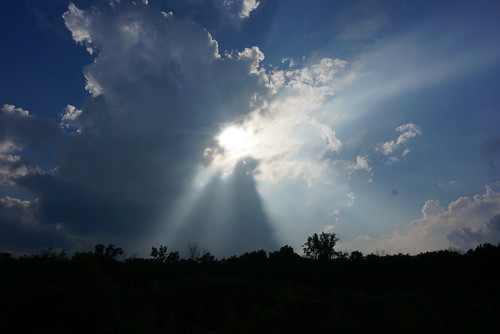
While our nation struggles to survive the COVID-19 pandemic, New Mexicans are already engaged in a deadly health crisis that has cost the lives of thousands of our beloved family and community members for the past 75 years. This crisis is the overexposure to radiation from the world’s first nuclear bomb detonation at Trinity Site in south central New Mexico on July 16, 1945. In the process it made many New Mexicans the first “Downwinder” communities exposed to radiation from nuclear weapons. The Trinity test in New Mexico was followed by the bombing of Hiroshima and Nagasaki three weeks later and we are all memorializing our dead on this 75th anniversary of the nuclear age. And just as the country is waiting for a pandemic recovery plan, New Mexicans are still waiting to be included in the Radiation Exposure Compensation Act (RECA) found in U.S. House Bill 3783.
Obscure agency writing off state politician’s debt
““…Romero and various board members charged taxpayers for lunches in and around Santa Fe. These meals for a select group in no way furthered the public interest. They only benefited coalition insiders.”
BY: Milan Simonich | santafenewmexican.com
You miss a few payments on the $7,800 you owe on your car. A repo agent will take away your ride and your pride while the neighbors watch.
You fail to make payments on a years-old $7,800 credit card bill. The lender will make certain you suffer from the worry of being sued. All the while your debt will balloon with interest charges and late fees.
That’s the real world. Life isn’t as hard in the echelon of state Rep. Andrea Romero and her former employer, the Regional Coalition of LANL Communities.
The coalition’s board claims Romero still owes it $7,800 for impermissible expenses accrued during her tenure as its executive director from March 2016 to February 2018. It asked Romero in May to pay the bill.
Nuclear Power goes South in South Carolina
“It looks like crime might well pay after all.”
That was the weary and only slightly tongue-in-cheek conclusion drawn by longtime anti-nuclear campaigner, Tom Clements recently, after a former South Carolina nuclear utility executive pled guilty to fraud in federal court.
BY: Linda Pentz Gunter | beyondnuclear.org
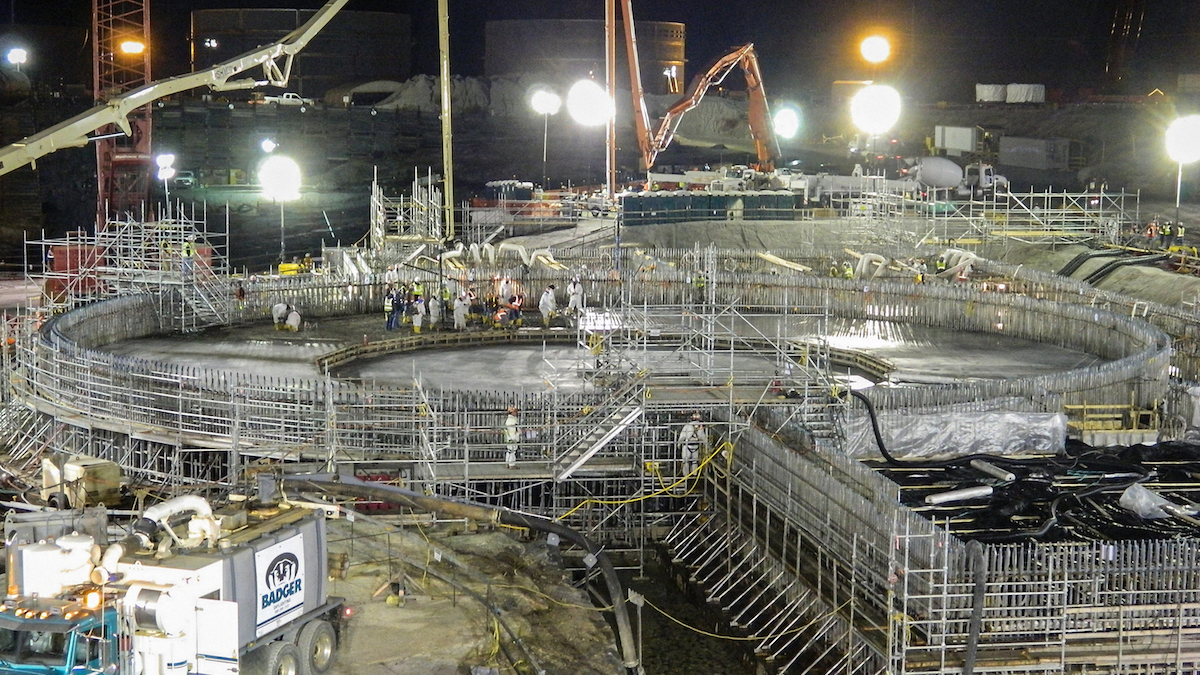
Clements is the director of Savannah River Site Watch, but his activism has, for decades, extended well beyond the perimeter of that vast nuclear site.
For years, Clements and others have followed — and attempted to stand in the way of — the forced march of South Carolina ratepayers toward nuclear fiasco. When it finally unraveled in late July, there was only cautious cause for celebration.
On July 23, Stephen Byrne, the former COO of SCANA, the South Carolina utility originally in charge of the construction of two new nuclear reactors in the state, pled guilty in a massive nuclear conspiracy that defrauded ratepayers, deceived regulators and misled shareholders.
Hiroshima survivor Dr. Hideko Tamura Snider, August 9, 2020
On August 9, 2020, Dr. Hideko Tamura Snider, author of “One Sunny Day” and “When A Peace Tree Blooms,” joined WILPF US Disarm/End Wars Committee and #HiroshimaNagasaki75 in describing her experiences before, during and after the Hiroshima bomb, and appealing to us all, “I depend on all of your energy, please continue what you are doing to rule out violent means, especially this inhumane, horrible weapon…. We are not barbarians, we are humans, and let us be truly and fully human….”
https://youtu.be/KYzuoGuqg34
75th Anniversary Timeline webinars at the WILPF US Disarm Committee YouTube channel – https://bit.ly/wilpfus-disarmyoutube
Jay Coghlan on The Richard Eeds Show August 3, 2020
The Richard Eeds Show. 8/3 – Jay Coghlan of Nuclear Watch New Mexico on The Event Commemorating the 75th Anniversary of the Bombing of Hiroshima.
Anti-nuclear protests at Kings Bay
“Our mission is to stop the arms race…it’s a security risk and phenomenally expensive. This has become a business model and it’s deadly.” – Glenn Carroll, coordinator of Nuclear Watch South
By: GORDON JACKSON / thebrunswicknews.com

ST. MARYS / Organizers of an annual protest against nuclear weapons at Naval Submarine Base Kings Bay expected a large crowd to commemorate the 75th anniversary of the first atomic bomb dropped on Hiroshima, Japan, to help hasten the end of World War II.
Five people ended up standing outside a base gate Thursday holding signs with anti-nuclear weapons messages.
Glenn Carroll, coordinator of Nuclear Watch South, said the ongoing COVID-19 pandemic compelled many who were planning to attend to stay home for health concerns. But Carroll said her trip from Atlanta to join others with concerns about nuclear weapons Thursday was worth the time.
How New Tech Raises the Risk of Nuclear War
75 years after Hiroshima and Nagasaki, some experts believe the risk of the use of a nuclear weapon is as high now as it has been since the Cuban missile crisis.
BY: BRYAN WELSH | axios.com

The big picture: Nuclear war remains the single greatest present threat to humanity — and one that is poised to grow as emerging technologies, like much faster missiles, cyber warfare and artificial intelligence, upset an already precarious nuclear balance.
What’s happening: A mix of shifting geopolitical tensions and technological change is upsetting a decades-long state of strategic stability around nuclear weapons.
- Strategic stability is when no country has an incentive to launch a first nuclear strike, knowing that doing so would inevitably lead to a catastrophic response. It’s the “mutual” in “mutually assured destruction.”
- Arms control deals like the Intermediate-Range Nuclear Forces Treaty are collapsing, while faster hypersonic missiles are shrinking the already brief minutes available to decide how and whether to respond to a potential nuclear attack, meaning “the possibilities of a miscalculation are unfortunately higher than they have been in a long, long time,” says former Energy Secretary Ernest Moniz.
- As concerning as rising tensions are between the U.S. and Russia, or between the U.S. and a more assertive China, experts worry even more about the destabilizing effect of emerging technologies like cyber warfare and AI.
- “The black box of AI in the future of war makes it almost inherently unpredictable,” says P.W. Singer, a strategist at New America and author of “Burn-In” — and unpredictability is anathema to a nuclear balance held in place by predictability.
75 years after Hiroshima, should U.S. president have authority to launch nuclear attack?
On August 6, 1945, the United States dropped the first atomic weapon on Hiroshima, Japan. Seventy-five years later, [PBS] NewsHour revisits how the president became the sole authority on when nuclear weapons are used. Nick Schifrin reports and talks to former Secretary of Defense William Perry, co-author of “The Button: The New Nuclear Arms Race and Presidential Power from Truman to Trump.”
BY: Nick Schifrin | pbs.org
Judy Woodruff:
On August 6, 1945, the United States dropped the first atomic weapon on Hiroshima, Japan. In the coming days, we will examine this 75th anniversary, the bomb’s immediate aftermath and its lasting legacy. Today, Nick Schifrin looks at the president’s sole authority to launch such a weapon and how that authority came to be.
The 75th Anniversary of Hiroshima and Nagasaki: A Renewed Call for Our Day
“A world of peace, free from nuclear weapons, is the aspiration of millions … ” — Pope Francis, Address at Atomic Bomb Hypocenter Park (Nagasaki), November 24, 2019.
PEOPLE OF GOD – Santa Fe Archdiocese, August 2020
PRAY
Pray with your community for the causes of peace and nuclear disarmament to be made a reality.
- Sample bulletin announcements and prayers of the faithful for use on August 2nd and 9th, 2020.
- Share this prayer (en Español) with your networks, or other prayers for peace on August 9th.
LEARN
Learn about what the Church teaches regarding nuclear weapons.
- Nuclear Weapons and Our Catholic Response: A Catholic Study Guide for use with the filmNuclear Tipping Point, revised June 2020.
- Statements of the U.S. bishops on Nuclear Weapons
- Pope Francis on Nuclear Weapons at Atomic Bomb Hypocenter Park (Nagasaki), November 24, 2019.
ACT
Put what your faith into action by raising your voice to support nuclear disarmament.
- Tell Congress to support extension of the New START Treaty and a continued U.S. moratorium on nuclear testing.
- Ask your friends and family to join you in taking action.
On 75th Anniversary of Japan Nuclear Bombings, Sierra Club Continues Calls for Elimination of Nuclear Weapons
Today, the Sierra Club rises with the survivors of the Hiroshima and Nagasaki nuclear bombings in continuing our call for an elimination of all nuclear weapons worldwide. The creation and storage of nuclear weapons is inherently risky, and accidents, testing, and use of nuclear weapons are recklessly and unnecessarily dangerous for communities — particularly low income and communities of color — and our environment.
“The Sierra Club calls on Congress to resist the current renewal of the nuclear arms race and to ban the use of nuclear weapons.”
Thursday, August 6, 2020 – Contact: Cindy Carr, cindy.carr@sierraclub.org
 WASHINGTON, D.C. — To commemorate the 75th anniversary of the WW II nuclear bombings of Hiroshima and Nagasaki, the Sierra Club has joined with the Hibakusha Survivors in calling for the elimination of all nuclear weapons globally. Since 1945, nearly 100,000 nuclear weapons have been manufactured, costing trillions of dollars and destroying communities and the environment through the mining, refining, and weaponizing of uranium.
WASHINGTON, D.C. — To commemorate the 75th anniversary of the WW II nuclear bombings of Hiroshima and Nagasaki, the Sierra Club has joined with the Hibakusha Survivors in calling for the elimination of all nuclear weapons globally. Since 1945, nearly 100,000 nuclear weapons have been manufactured, costing trillions of dollars and destroying communities and the environment through the mining, refining, and weaponizing of uranium.
The Sierra Club opposes the creation and testing of nuclear weapons and supports the Treaty on the Prohibition of Nuclear Weapons (TPNW).
Urgency to bear witness grows for last Hiroshima victims
“We must work harder to get our voices heard, not just mine but those of many other survivors,” Lee [ Jong-keun] said in an interview Tuesday at the Hiroshima Peace Memorial Museum. “A nuclear weapons ban is the starting point for peace.”
Mari Yamaguchi Associated Press | santafenewmexican.com
HIROSHIMA, Japan
For nearly 70 years, until he turned 85, Lee Jong-keun hid his past as an atomic bomb survivor, fearful of the widespread discrimination against blast victims that has long persisted in Japan.
But Lee, 92, is now part of a fast-dwindling group of survivors, known as hibakusha, that feels a growing urgency — desperation even — to tell their stories. These last witnesses to what happened 75 years ago Thursday want to reach a younger generation that they feel is losing sight of the horror.
The knowledge of their dwindling time — the average age of the survivors is more than 83 and many suffer from the long-lasting effects of radiation — is coupled with deep frustration over stalled progress in global efforts to ban nuclear weapons. According to a recent Asahi newspaper survey of 768 survivors, nearly two-thirds said their wish for a nuclear-free world is not widely shared by the rest of humanity, and more than 70 percent called on a reluctant Japanese government to ratify a nuclear weapons ban treaty.
Atomic-bomb survivors seek new ways to keep their memories alive
Around the world, non-proliferation efforts are faltering
For seventeen year-old Takeoka Chisako, August 6th, 1945 was supposed to be a day off. She had planned to meet two girlfriends at 8:15 that morning, at a train station on the west side of Hiroshima. She was running late, and as she stepped outside her house she lifted a pocket mirror to her face. Then she saw a flash and heard a bang. When she regained consciousness she found herself lying in a potato field 30 metres away, a mushroom cloud rising in the sky. People with charred skin dangling from their arms came rushing over a nearby hillside. They cried for help, but were too feeble to speak their names and too weak to drink the water Ms Takeoka brought them. “Then one by one, they died,” says Higashino Mariko, Ms Takeoka’s daughter.
Hiroshima after 75 years: Walking the path of the atomic bomb
74-year-old [Kosei Mito] turns to a page in one of his binders with a large quote Pope John Paul II made during a visit to Hiroshima in 1981, one that’s inscribed on a memorial inside the Hiroshima Peace Museum.
“To remember the past is to commit oneself to the future.”
“You’re walking the path of the atomic bomb.”
Unlike the pandemic, nuclear war can be stopped before it begins
Seventy-five years after Hiroshima and Nagasaki, the anti-nuclear movement is taking big steps toward abolition.
BY: MARINA MARTINEZ | wagingnonviolence.org
Nuclear weapons have been posing a threat to humanity for 75 years — ever since the U.S. bombings of Hiroshima and Nagasaki in August 1945.
These days, our focus is understandably on the COVID-19 virus and the threat it poses to human life. But as we commemorate the anniversary of these bombings, it is important to acknowledge that unlike the coronavirus, nuclear weapons can only be remediated with prevention. Millions of people could be killed if a single nuclear bomb were detonated over a large city, and the added threats of radiation and retaliation could endanger all life on Earth.
U.S. LAUNCHES MINUTEMAN III MISSILE TEST LESS THAN 48 HOURS BEFORE 75TH ANNIVERSARY OF HIROSHIMA ATOMIC BOMBING
“The unnecessarily provocative test by the U.S. today is an important reminder that the nuclear threat remains very real, and that there are people in this country – along with a few other countries – who are willing to sacrifice us all in a battle that can never be won and must never be fought.”
 For Immediate Release Contact: Sandy Jones (805) 965-3443; sjones@napf.org
For Immediate Release Contact: Sandy Jones (805) 965-3443; sjones@napf.org
Rick Wayman (805) 696-5159; rwayman@napf.org ragingpeace.org
Santa Barbara, CA – The U.S. Air Force launched an unarmed Minuteman III intercontinental ballistic missile Tuesday morning, August 4, at 12:21 a.m. PDT from Vandenberg Air Force Base. The missile traveled over 4,200 miles to the Kwajalein Atoll in the Marshall Islands.
While Air Force Global Strike Command asserts that missile tests are scheduled years in advance, it is difficult to ignore the timing of this test – less than 48 hours before the 75th anniversary of the U.S. atomic bombing of Hiroshima.
Rick Wayman, CEO of the Nuclear Age Peace Foundation, a non-profit based in Santa Barbara committed to solving the most dangerous technological, social, and psychological issues of our time, including the abolition of nuclear weapons, commented on the missile test. He said, “This week, the majority of the world is solemnly remembering the 75th anniversaries of the U.S. atomic bombings of Hiroshima and Nagasaki, and vowing that such a thing will never happen again. Hundreds of thousands of our fellow human beings were indiscriminately slaughtered by two primitive U.S. atomic bombs in August 1945. The weapon that was tested this morning is designed for far greater damage.”
Trump team’s case for new nuke cites risks in current arsenal
The administration justified new atomic weapons by citing rarely acknowledged vulnerabilities in U.S. nuclear arsenal
BY: JOHN M. DONNELLY | rollcall.com
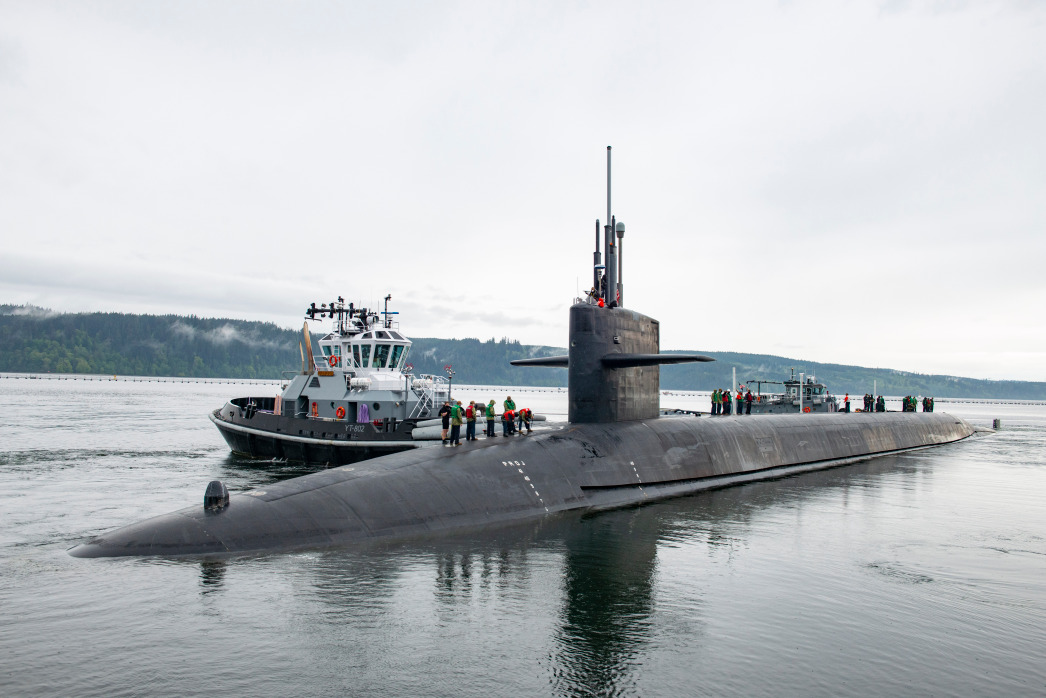
The Trump administration, in a closely held memo to lawmakers this spring, justified developing the first new U.S. atomic weapon since the Cold War by citing vulnerabilities and risks in the current nuclear arsenal that are rarely or never acknowledged in public.
In an unclassified five-page white paper sent to Congress in May, the Pentagon and the Energy Department’s National Nuclear Security Administration, or NNSA, affirm a point they have long minimized: the dangers of land-based missiles ready to launch minutes after a warning of enemy attack.
They also discuss threats to U.S. nuclear missile submarines that have previously been depicted as all but undetectable. They say, too, that a new class of ballistic missile submarines lacks the firepower of its predecessors, creating a need for a lighter and more powerful type of warhead — in addition to the two existing types. As for the current two sets of warheads, they say they have too few of the most destructive kind and too many of the less forceful variety — and excessively rely on the latter.
Gov. argues against Holtec nuclear storage site
Gov. Michelle Lujan Grisham sent a letter to President Donald Trump on Tuesday, arguing against a proposed nuclear waste interim storage facility in southeast New Mexico.
“The proposed (facility) would join the ranks of uranium mining, nuclear energy and defense-related programs that have long created risks to public health and the environment in the state of New Mexico that are disproportionately greater than such risks to the general population of the United States,” she wrote.
BY: THERESA DAVIS, JOURNAL STAFF WRITER | Copyright © 2020 Albuquerque Journal
The proposed Holtec International site would store 500 stainless steel canisters of the nation’s spent nuclear fuel on 1,000 acres between Carlsbad and Hobbs, with a full storage capacity of 10,000 canisters.
“New Mexico has grave concerns for the unnecessary risk to our citizens and our communities, our first responders, our environment, and to New Mexico’s agriculture and natural resource industries,” Lujan Grisham wrote in the letter.
LANL trolley that carries radioactive material broken down
“If LANL can’t drive a trolley or clean up old stuff without exposing people, how can they safely expand plutonium pit production?” asked Scott Kovac, research and operations director for nonprofit Nuclear Watch New Mexico.
BY: SCOTT WYLAND | santafenewmexican.com
An internal trolley that carries radioactive material to several glove-box areas at Los Alamos National Laboratory’s plutonium facility has been broken for almost two months, hindering operations at the site, a federal watchdog report said.
The trolley became disabled in early June, and its bucket is stuck with a container of nuclear material inside, according to a report issued by the Defense Nuclear Facilities Safety Board.
“However, the location is not creating any radiological exposure concerns,” the report said.
The report noted the idled trolley has hampered the internal transfer of radioactive material to the sealed containers with protective gloves attached, but it didn’t say to what extent.
“F-35s Don’t Help Families Pay Their Bills”: GOP Slips Pentagon Into COVID Bill
“People are dying, or worried about keeping a roof over their families’ heads, or cutting hours because their kids’ schools are closed,” said Anthony Weir, a lobbyist on nuclear disarmament and Pentagon spending at the Friends Committee on National Legislation. “And this is the time to jam some military procurement into this year that you didn’t get last year?”
BY: JAKE JOHNSON | truthout.org

SAMUEL KING JR. / U.S. AIR FORCE
In a floor speech late Monday, Senate Majority Leader Mitch McConnell described the GOP’s newly released coronavirus stimulus package as a “carefully tailored” plan to provide financial relief to desperate Americans.
But a look at the legislative text (pdf) released by Senate Republicans shows the HEALS Act is replete with massive gifts to the Pentagon and defense contractors that would do nothing to aid the unemployed, provide nutrition assistance to hungry children, prevent an avalanche of evictions, or stop the spread of coronavirus.
“Last time I checked F-35s don’t help families pay their bills,” Rep. Chuy García (D-Ill.) tweeted in response to the GOP’s proposal of $686 million in spending on new fighter jets.
Pending Energy Spending Bill Mixed Bag for INL
“We all know major change takes time, and we know that it is difficult to turn this ship, but we are doing it in our time…We can and must do better than refight a tired old battle on Yucca Mountain.” – Rep. Marcy Kaptur, D-Ohio
By: NATHAN BROWN | postregister.com
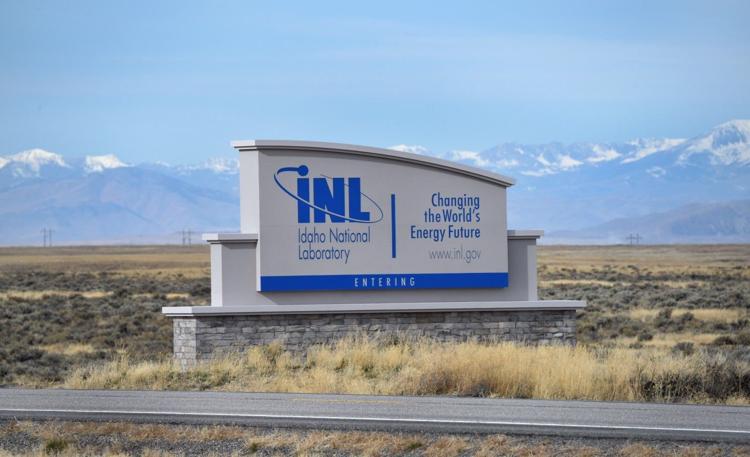
The Energy and Water appropriations bill Congress is expected to take up next week represents a mixed bag for Idaho National Laboratory, with spending on some priorities kept flat and slight increases for others.
The U.S. House Appropriations Committee voted along party lines earlier this month, with the Democrats in favor and the Republicans opposed, to advance the bill. At $49.6 billion in the regular budget, it represents a $1.26 billion increase over this year’s spending, according to a committee reporting summarizing the bill. However, on top of this it also includes an additional $23.5 billion in emergency one-time funding meant to bolster various clean energy projects and aid in recovery from the coronavirus pandemic that has led to pushback from Republicans. It and six other spending bills are expected to be considered by the full House this week, according to a news release from the committee.
Rep. Tulsi Gabbard Rebuts U.S. Claim that Marshall Islands Nuclear Waste Site is Safe
“The U.S. government is responsible for this storage site and must ensure the protection of the people and our environment from the toxic waste stored there,” Gabbard said in a news release announcing her amendment to the defense bill.
BY: SUSANNE RUST | latimes.com

One of Hawaii’s high-profile politicians has dismissed a recent Department of Energy report concluding that a leaking U.S. nuclear waste repository in the Marshall Islands is safe for people there.
She called for the department to convene a more independent assessment of the waste site.
“I think it’s time the Department of Energy relied on someone with fresh eyes to examine the situation,” said U.S. Rep. Tulsi Gabbard, one of Hawaii’s two Democratic House members, in a recent interview with The Times.
Gabbard, who gained national attention by launching what some called a quixotic campaign for the Democratic presidential nomination, has been outspoken in Congress on behalf of the Marshall Islands, which the United States used as a testing site for scores of nuclear weapons during the Cold War.
She’s pushed to reinstate Medicaid eligibility to people from the Marshall Islands, Micronesia and Palau who are working and living in the United States but lack access to healthcare. She also was instrumental in requiring the Department of Energy to reexamine the safety of Runit Dome, a leaking nuclear waste repository in the Marshall Islands, as part of the 2019 National Defense Authorization Act.
Novel gas-capture approach advances nuclear fuel management
“If one day we want to treat the spent fuels, which in the U.S. are currently stored in pools and dry casks at the nuclear power plant sites, we need to handle the volatile radionuclides.” explains Ju Li, MIT’s Battelle Energy Alliance Professor of Nuclear Science and Engineering and professor of materials science and engineering. “Physisorption of krypton and xenon is a good approach, and we were very happy to collaborate with this large team on the MOF approach.”
By: PETER DUNN, MIT | phys.org

Nuclear energy provides about 20 percent of the U.S. electricity supply, and over half of its carbon-free generating capacity.
Operations of commercial nuclear reactors produce small quantities of spent fuel, which in some countries is reprocessed to extract materials that can be recycled as fuel in other reactors. Key to the improvement of the economics of this fuel cycle is the capture of gaseous radioactive products of fission such as 85krypton.
Therefore, developing efficient technology to capture and secure 85krypton from the mix of effluent gasses would represent a significant improvement in the management of used nuclear fuels. One promising avenue is the adsorption of gasses into an advanced type of soft crystalline material, metal organic frameworks (MOFs), which have extremely high porosity and enormous internal surface area and can incorporate a vast array of organic and inorganic components.
Top Ex-SCANA Official Stephen Byrne Pleads Guilty in SC Nuclear Fiasco Fraud Case
Stephen Byrne, a top executive of the now-defunct SCANA electric utility, pleaded guilty Thursday to criminal conspiracy fraud charges in federal court in Columbia.
BY: John Monk & Joseph Bustos | thestate.com
Byrne was part of a conspiracy that engineered a “cover-up” to hide the extent of the publicly traded company’s financial problems caused by the nuclear project’s difficulties, according to charging documents in his case. “Through intentional misrepresentations,” Byrne and others deceived regulators and customers, documents said.
White House held talks over resuming US nuclear tests, John Bolton says
Ex-Trump adviser and testing advocate tells Guardian ‘certainly it was discussed’ but no decision was made by the time he left
BY: JULIAN BORGER | theguardian.com
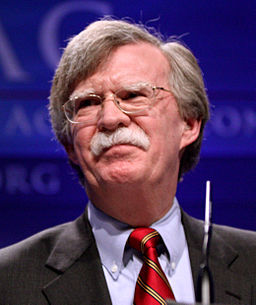
White House officials held a series of discussions over the past two years on the possibility of resuming US nuclear testing, according to the former national security adviser John Bolton.
“Certainly the subject was discussed,” Bolton, a fierce advocate of testing, told the Guardian. However, there was opposition from some in the administration who felt current computer-based testing of US warheads was sufficient, and no decision was made by the time Bolton left the White House last September.
When the prospect of the first US underground nuclear test in nearly three decades came up at a White House meeting in May, it triggered an outcry from arms control advocates and a Democratic amendment to the 2021 National Defense Authorization Act, blocking funding for preparations for a test.
Bolton, who has published a memoir on his time in the Trump White House titled The Room Where It Happened, said the issue was discussed in general terms on a number of occasions while he was national security adviser from April 2018 to September 2019. However, the discussions did not become “operational” as his priority had been to take the US out of the Intermediate-range Nuclear Forces (INF) treaty.
Ohio Nuclear Power Scandal
As [David] DeVillers described it at a press conference: it was the “largest bribery, money laundering scheme ever perpetrated against the people of Ohio.”
BY: KARL GROSSMAN | counterpunch.org
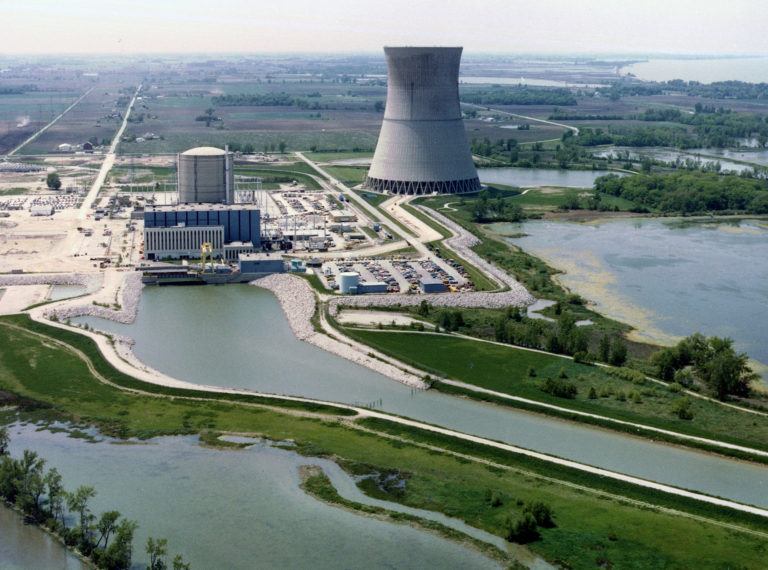
The U.S. Attorney’s Office and FBI this week charged the speaker of the Ohio House of Representative and four others in a $61 million scheme to use $1 billion in ratepayers money to keep two decrepit nuclear power plants operating.
And, said the U.S. Attorney for the Southern District of Ohio, David DeVillers, at a press conference after the arrests Tuesday: “This is by no means over. We are going to continue with this investigation.”
Those charged were involved in a “Conspiracy to Participate, Directly or Indirectly” in the scheme “through a Pattern of Racketeering Activity,” declared the “Offense Description” that headed an 81-page federal “Criminal Complaint.”
A Dirty Battle for a Nuclear Bailout in Ohio
“It has been known since the late 1970s that the cost of constructing nuclear plants in the United States is very high, but the cost gap between nuclear electricity and other alternatives has increased dramatically in the last decade. In its most recent estimate, the Wall Street firm Lazard estimated that a new nuclear plant will generate electricity at an average cost of $155 per megawatt hour, nearly four times the corresponding estimates of around $40 per megawatt hour each for new wind and solar energy plants. The average cost for natural gas plants is $56 per megawatt hour.
The gap will only grow larger. While the costs of nuclear power have been increasing, the costs of wind and solar power have declined by around 70 to 90 percent in the last decade.”
BY: Shakiba Fadaie & M. V. Ramana | thebulletin.org

Last July, Ohio’s governor signed House Bill 6 (HB6) to provide FirstEnergy (now Energy Harbor), a large electric utility, with subsidies of nearly $150 million per year to keep its Perry and Davis-Besse nuclear power plants operating. Ohio is only the fifth US state to offer such subsidies; other states include New York, Illinois, New Jersey, and Connecticut. Although the subsidies are justified by some as necessary for climate mitigation, in the latter four states, electricity generation from natural gas, which results in greenhouse gas emissions, has increased since 2017, when these subsidy programs started kicking in. Moreover, in Ohio, subsidies are also being extended to coal power plants, providing the clearest illustration that what underlies the push for subsidies to nuclear plants is not a result of a real commitment to climate mitigation but a way to use climate concerns to bolster the profits of some energy corporations.
Video: Obstacles to Nuclear Abolition — a discussion with David Swanson, Alice Slater, and Bruce Gagnon
David Swanson, Alice Slater, and Bruce Gagnon discuss obstacles to nuclear abolition and the U.S.-Russia relationship.
Inhofe, Reed Praise Senate Passage of National Defense Authorization Act for Fiscal Year 2021
The United States Senate today passed the National Defense Authorization Act for Fiscal Year 2021, 86-14.
Thursday, July 23, 2020 PRESS RELEASE: https://www.armed-services.senate.gov/press-releases/inhofe-reed-praise-senate-passage-of-national-defense-authorization-act-of-fiscal-year-2021
- Full text of Bill: https://www.congress.gov/116/bills/s4049/BILLS-116s4049rs.pdf
- Report to go with Senate NDAA, which passed the full Senate on July 23: https://www.congress.gov/116/crpt/srpt236/CRPT-116srpt236.pdf
Responsibility for Los Alamos Plutonium Facility 4 and Technical Area 55
Plutonium Facility 4 (PF–4) at Los Alamos National Laboratory’s Technical Area 55 is the primary plutonium handling facility within the National Nuclear Security Administration (NNSA). PF–4 is currently undergoing major modifications to produce war reserve plutonium pits, with a production goal of 30 pits per year by 2026.Continue reading
Bribed Ohio’s $60 Million Radioactive Uproar Rocks the 2020 Vote
“Ohio is in election-year turmoil over a Trump-supported nuke bailout bought with bribery. Whether public fury will kill the handout and affect the fall presidential election remains to be seen…But Bribed Ohio 2020 has clearly gone radioactive.”
BY: Bob Fitrakis & Harvey Wasserman | readersupportednews.com
Ohio’s biggest-ever bribery case is rocking America’s reactor industry … and the fall election.
Full details of the shocking arrest of Ohio’s powerful Speaker of the House are still unfolding.
But on Monday, the FBI charged Larry Householder and four associates with taking $60 million (that’s NOT a typo) in bribes from “Company A,” suspected to be the Akron-based nuke utility FirstEnergy. The company has not been formally named as the source of the bribe, but FE’s stock has since plummetted.
Trinity: 75 Years Later
On the 75th anniversary of the world’s first nuclear weapons explosion: The Trinity test near Alamogordo in 1945, KSFR News Director Tom Trowbridge spoke with a longtime New Mexico journalist about the anniversary.
Nuclear News Archives – 2019
Radioactive pollution leaked through floor of South Carolina nuclear fuel plant
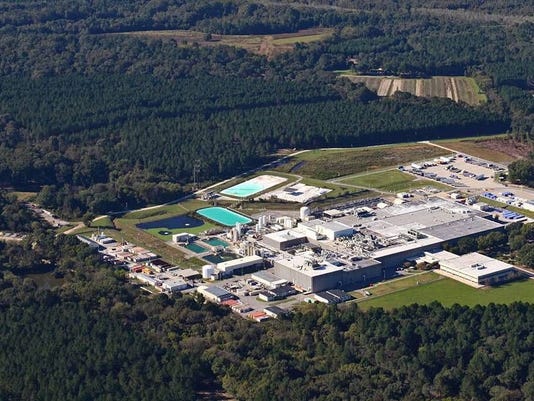
(Photo: Courtesy of High Flyer/The State)
BY SAMMY FRETWELL | greenvilleonline.com
Radioactive uranium has leaked through the floor at Westinghouse’s Bluff Road fuel factory, contaminating the soil in an area of Richland County with a nearly 35-year history of groundwater pollution from the plant.
The U.S. Nuclear Regulatory Commission says the uranium, a toxic substance used to make nuclear fuel rods, seeped through a 3-inch hole in a concrete floor in part of the factory where an acid is used. The hole extends 6 feet into the ground, according to the NRC. The NRC learned of the leak July 12.
Are We Headed for Another Expensive Nuclear Arms Race? Could Be.

BY STEVEN ERLANGER | nytimes.com
BRUSSELS — After the recent death of the treaty covering intermediate-range missiles, a new arms race appears to be taking shape, drawing in more players, more money and more weapons at a time of increased global instability and anxiety about nuclear proliferation.
The arms control architecture of the Cold War, involving tens of thousands of nuclear weapons, was laboriously designed over years of hard-fought negotiations between two superpowers — the United States and the Soviet Union. The elaborate treaties helped keep the world from nuclear annihilation.
Pakistan downgrades diplomatic ties, suspends trade with India over Kashmir
Kashmir in lockdown as India plans to change state’s status
BY JESSIE YEUNG & SOPHIA SAIFI | cnn.com
Islamabad, Pakistan (CNN) Pakistan has announced it will downgrade diplomatic relations and suspend bilateral trade with India after New Delhi stripped the disputed state of Jammu and Kashmir of its special status. India’s High Commissioner will also be removed from the country, Pakistan’s Ministry of Foreign Affairs said in a statement Wednesday. It added that Islamabad will not send its own ambassador to New Delhi.
The series of announcements came after a National Security Committee meeting on Wednesday, where the office of Pakistan’s Prime Minister Imran Khan said that Islamabad would also review bilateral agreements with India and take the issue up with the United Nations and the UN Security Council.
TPNW is now officially halfway towards entry into force!
On August 6th, 1945 at 8:16 am, a nuclear bomb was dropped on the city of Hiroshima, killing over 140,000 people and wiping out most of the city. 74 years later, the bomb’s catastrophic consequences are still affecting people’s lives.

Today, tens of thousands of people have gathered in Hiroshima, and around the world, to commemorate the victims and echo the call of the Hibakusha – the survivors of the bombings of Hiroshima and Nagasaki – that such a thing must never happen again. And at the UN in New York, one such commemoration took a very special form today: Bolivia has just marked Hiroshima Day by depositing its ratification instrument for the UN Treaty on the Prohibition of Nuclear Weapons (TPNW). With this ratification, TPNW is now officially halfway towards entry into force!
Read more about this special moment
The Human Cost of the Hiroshima Bombing
PODCAST: Listen to the story of Kathleen Burkinshaw, the daughter of a survivor of the Hiroshima bombing. Kathleen reminds us that she and her mother are among the tens of thousands of people who view nuclear weapons in terms of the friends and family members they lost.
? New Podcast Alert ?: in memory of the 74th anniversary of the bombing of Hiroshima, Nukes of Hazard podcast host @NuclearWilson sat down with @klburkinshaw1, daughter of a #Hiroshima survivor, to discuss the human cost of the bombing. Listen here: https://t.co/iNs05KkbXc pic.twitter.com/YHm6py7Fnr
— Nukes of Hazard (@nukes_of_hazard) August 6, 2019
“For this week’s Press the Button, we mark the 74th anniversary of the Hiroshima bombing with a special edition episode.”
Listen and subscribe to Press the Button, a weekly podcast from Ploughshares Fund dedicated to nuclear policy and national security.
August 6th — Two interrelated issues are discussed: Should US policy today still reserve the right to use nuclear weapons first, and what happened when we did go first nearly three quarters of a century ago?
“To help answer these questions, we bring you the very best from a multitude of our earlier interviews. You’ll hear from nuclear historian Alex Wellerstein, former Obama deputy national security advisor Ben Rhodes, former RAND analyst and releaser of the Pentagon Papers Daniel Ellsberg, founding director of the Consortium on Gender, Security and Human Rights Carol Cohn, and Beatrice Fihn, executive director of the Nobel Peace Prize-winning International Campaign to Abolish Nuclear Weapons (ICAN).
Also featuring special guest Kingston Reif from the Arms Control Association, to discuss recent nuclear news on the Early Warning segment. Kingston talks about the INF Treaty withdrawal, no-first-use, and the latest from Iran..
Listen, Subscribe and Share on iTunes · Spotify · SoundCloud · Google Play
Also available on ploughshares.org/pressthebutton
The Democratic Debates Need More Questions About Nuclear War
There is a remarkable incongruity between the existential danger of nuclear war and the absence of public discussion about preventing it. This disconnect is all too apparent today, as arms control and disarmament treaties are scrapped, nations embark on vast nuclear weapons buildups, and governments threaten nuclear war against one another.

SCOTT OLSON / GETTY IMAGES
BY LAWRENCE WITTNER |truthout.org
Meanwhile, the mass media routinely avoids these issues but, instead, focuses on movie stars, athletes, and President Donald Trump’s latest tweeted insults.
Do I exaggerate? Consider the following.
In May 2018, the Trump administration unilaterally withdrew from the laboriously constructed Iran nuclear agreement that had closed off the possibility of that nation developing nuclear weapons. The U.S. pullout was followed by the imposition of heavy U.S. economic sanctions on Iran, as well as by thinly veiled threats by Trump to use nuclear weapons to destroy that country. Irate at these moves, the Iranian government recently retaliated by exceeding the limits set by the shattered agreement on its uranium stockpile and uranium enrichment.
NNSA Weighing Whether Nuke Parts Delays Could Prevent Timely Deployment
EXCHANGE MONITOR | exchangemonitor.com

The National Nuclear Security Administration (NNSA) is still determining if problems with non-nuclear components will prevent the B61-12 gravity bomb and W88 Alt 370 submarine-launched ballistic missile warhead from entering service with the Air Force and Navy.
Arms Control Association – Statement on U.S. Withdrawal from the INF Treaty
“The loss of the landmark INF Treaty, which helped end the Cold War nuclear arms race, is a blow to international peace and security.”
Statement from Daryl G. Kimball, executive director | armscontrol.org | Media Contacts: Daryl G. Kimball, executive director, 202-463-8270 ext. 107; Kingston Reif, director for disarmament policy, 202-463-8270 ext. 104
“Russian noncompliance with the INF Treaty is unacceptable and merits a strong response. But President Trump’s decision to terminate the treaty will not eliminate Russia’s noncompliant 9M729 missiles — and is a mistake.
“Worst of all, blowing up the INF Treaty with no substitute arms control plan in place could open the door to a dangerous new era of unconstrained military competition with Russia.
Communities in the American Southwest Were Exposed to Nuclear Fallout. Can They Get Compensated?
Radiation epidemiology is a science of uncertainty.
BY: ARIA ALAMALHODAEI | motherjones.com
The atomic bomb was born in the desert. In the early hours of July 16, 1945, after a spate of bad weather, a 20-kiloton plutonium-based nuke referred to as “the gadget” detonated near Alamogordo, New Mexico. Firsthand testimonies of the test, codenamed Trinity, converge on the uncanny axis of awe and dread.
The Manhattan Project’s Chief of Field Operations, General Thomas Farrell, wrote that “the strong, sustained, awesome roar…warned of doomsday and made us feel that we puny things were blasphemous.”
The bomb produced a massive cloud column that drifted in several directions, dusting large swaths of the surrounding region with radioactive snow—fallout that settled on buildings, plants, and animals, and that continued to permeate the air as invisible particulate in the weeks and months that followed. Five years later, the Nevada Test Site was established to continue the work that Trinity set alight.
Although the mushroom cloud became the icon of American nuclear activity in the 20th century, the harms of these bombs did not fade with their dimming fireballs. No group in the US understands this better than the downwinders, communities throughout the American Southwest and beyond who were exposed to the fallout of the military’s domestic nuclear test program.
The INF Treaty Officially Died Today
Six months after both the United States and Russia announced suspensions of their respective obligations under the Intermediate-Range Nuclear Forces Treaty (INF), the treaty officially died today.
Federation of American Scientists | Posted on Aug.02, 2019 in Arms Control, Nuclear Weapons, Russia, United States by Hans M. Kristensen & Matt Korda
The Federation of American Scientists strongly condemns the irresponsible acts by the Russian and US administrations that have resulted in the demise of this historic and important agreement.
In a they-did-it statement on the State Department’s web site, Secretary of State Michael Pompeo repeated the accusation that Russia has violated the treaty by testing and deploying a ground-launched cruise missile with a range prohibited by the treaty.
“The United States will not remain party [sic] to a treaty that is deliberately violated by Russia,” he said.
By withdrawing from the INF, the Trump administration has surrendered legal and political pressure on Russia to return to compliance. Instead of diplomacy, the administration appears intent on ramping up military pressure by developing its own INF missiles.

Today, 2 August 2019, the governments of the US and Russia have missed a troubling deadline: the end of the six-month notice period that began when both countries announced their withdrawal from the INF Treaty earlier this year. During this period, the decision could still be reversed if both parties went back to the negotiating table. Now that the deadline has passed, and both states can produce even more nuclear weapons, this time enabled to hit targets in the range of 500 and 5,500 kilometres. These weapons, optimised to destroy cities and wipe out civilian populations, put the whole world – and Europe in particular – at risk.
A nuclear treaty is about to vanish. Its demise should teach a lesson.
On Friday, a pillar of global security will expire.
BY EDITORIAL BOARD | washingtonpost.com
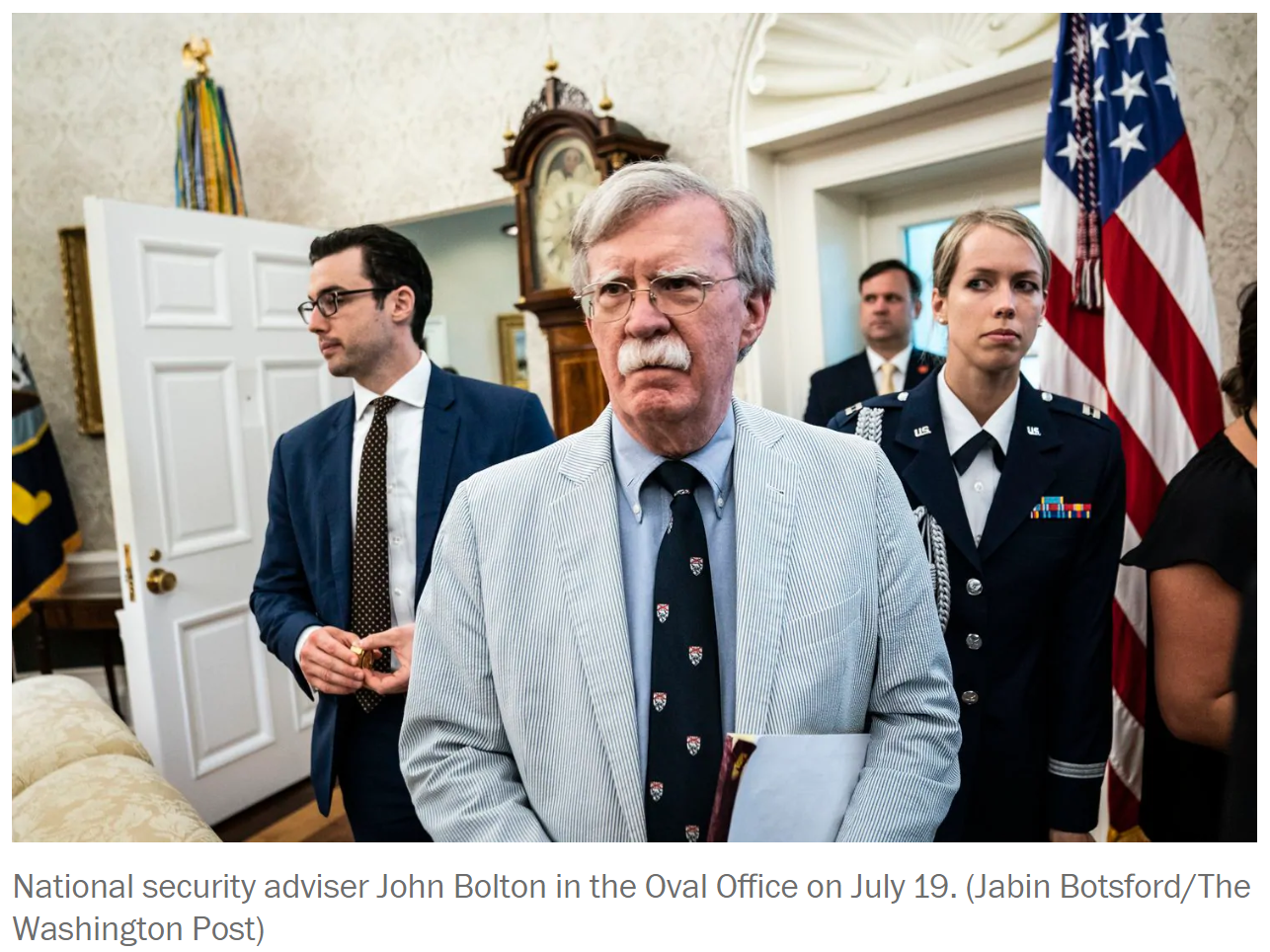 Perhaps no one will notice when the Intermediate-range Nuclear Forces Treaty of 1987 slips into oblivion; the threat of nuclear attack in just minutes that seemed so unnerving during the late 20th century has now faded into a distant memory, lost to complacency at the Cold War’s end. But the demise of the INF Treaty should teach a lesson.
Perhaps no one will notice when the Intermediate-range Nuclear Forces Treaty of 1987 slips into oblivion; the threat of nuclear attack in just minutes that seemed so unnerving during the late 20th century has now faded into a distant memory, lost to complacency at the Cold War’s end. But the demise of the INF Treaty should teach a lesson.
Arms control, creating verifiable treaties to limit and reduce nuclear, chemical and biological weapons, had its mystique: obtuse concepts, exotic hardware and mind-bending negotiations. But at its core, arms control was about political willpower. In the case of the INF Treaty, President Ronald Reagan and Soviet leader Mikhail Gorbachev summoned enough of it to eliminate an entire class of deployed weapons, the ground-based missiles with a range of between 300 and 3,400 miles, and their launchers. The treaty made the world safer not only by removing a nuclear threat to Europe but also by introducing novel measures such as intrusive verification and on-site inspections.
If New START Dies, These Questions Will Need Answers
There’s little public indication that the Trump administration is thinking about several things that will happen if the last strategic arms agreement is allowed to expire.
BY VINCENT MANZO & MADISON ESTES | defenseone.com

A U.S. Air Force B-52H Stratofortress bomber takes off from Andersen Air Force Base, Guam, for a routine training mission in the vicinity of the South China Sea and Indian Ocean, Sept 23, 2018.
The Trump administration has articulated an ambitious new vision for nuclear arms control, one that includes China and seeks to limit more types of Russian systems. This vision appears to have little room for the New START agreement, which helped to cap U.S. and Russian nuclear arsenals and which is due to expire in 2021. And yet there is little in the public record to indicate how the administration would deal with various problems that would surface if New START is left to die.
Did Trump Just Threaten to Attack Iran With Nukes?
He said he could destroy Afghanistan but was signaling elsewhere. The scary part is there’s already a plan.
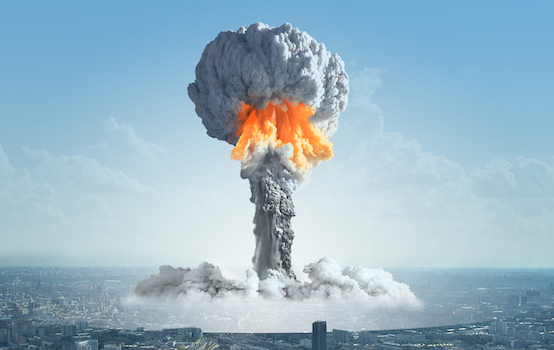
BY SCOTT RITTER | theamericanconservative.com July 25, 2019
On Monday during a press conference between Donald Trump and Pakistani Prime Minister Imran Khan, Trump spoke rather casually of having reviewed plans to annihilate Afghanistan.
“I could win that war in a week. I just don’t want to kill 10 million people,” Trump said. “I have plans on Afghanistan that if I wanted to win that war, Afghanistan would be wiped off the face of the earth, it would be gone. It would be over in, literally, in 10 days. And I don’t want to go that route.”
Trump’s seemingly blasé reference to a hypothetical mass murder on a scope and scale never seen in the history of mankind (it took Nazi Germany more than four years to kill six million Jews) was stunning. We know, given the state of play in Afghanistan, that it will never happen. But it wasn’t offhand. Such a policy of total destruction could also be seen as applying to Iran, and the potential for the use of nuclear weapons in the event of a U.S.-Iranian conflict is far from hypothetical. He knew exactly what he was doing.
Continue reading
As we mark the seventy-fourth anniversary of the Hiroshima and Nagasaki bombings in a handful of days, we will rightly remember the horrors of nuclear war.
BY ZACK BROWN & ALEX SPIRE
For a brief fraction of a second on an early March morning in 1954, the United States summoned a second sun into existence above Bikini Atoll.
As the four-mile wide fireball bathed the Pacific seascape in its angry, white-red light, onlookers recognized something nearly divine—and unquestionably ominous. “It was a religious experience, a personal view of the apocalypse or transfiguration,” said one observer. Another remembered feeling “like you stepped into a blast furnace,” even though he was over thirty miles away.
This was the Castle Bravo thermonuclear test, one of several dozen nuclear detonations the United States carried out in the Marshall Islands during the Cold War. At 15 million tons of TNT—one thousand times more powerful than the bomb that destroyed Hiroshima—it was the largest explosion ever set off by Americans.
Yukiya Amano, Head of the I.A.E.A. Nuclear Watchdog Group, Dies at 72
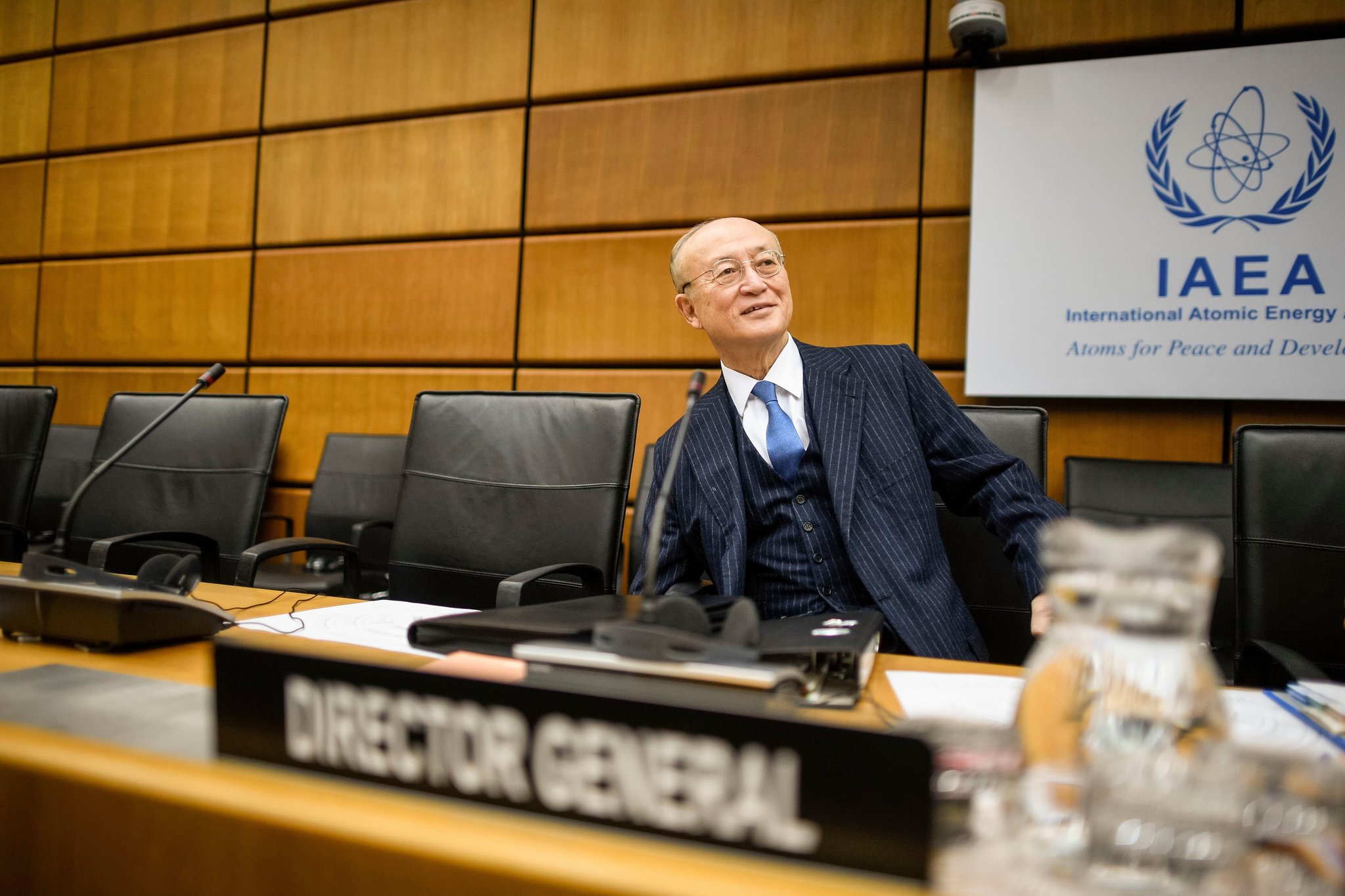
BY MEGAN SPECIA & DAVID E. SANGER | nytimes.com July 22, 2019
Yukiya Amano, a Japanese diplomat who played a central role in inspecting Iran’s compliance with the landmark 2015 nuclear deal as the head of the International Atomic Energy Agency in Vienna, has died, the organization announced on Monday. He was 72.
The agency, part of the United Nations, did not cite a cause of death or say when and where he died, but word had begun to spread last week that Mr. Amano had planned to step down from his position as director-general after nearly a decade because of an unspecified illness. He was two years into a third term as the agency’s leader.
His death left the agency leaderless at a critical moment: just as Iran is edging away from the nuclear agreement and beginning carefully calibrated violations of the limits on how much nuclear material it can produce, and at what level of purity.
Inside the Secret Campaign to Export U.S. Nuclear Tech to Saudi Arabia
Industry coalition’s push to win over the Trump administration is concerning officials on Capitol Hill who are fearful that it could threaten U.S. national security.

ERIN BANCO | thedailybeast.com
When President Donald Trump took the stage in the East Room of the White House earlier this month to give his first speech on the environment, nuclear energy executives and industry leaders held their breath. They exchanged text messages with fellow colleagues during the speech’s broadcast, wondering aloud to one another if Trump had taken the bait.
Since the fall of 2016, the executives have built an underground coalition along with academics, technology experts and well-connected politicos, including some lobbyists, to get the president and his administration to support—even promote—an American nuclear energy comeback. The industry has declined in recent years due mostly to the closing of critical nuclear infrastructure and plants. Between 2010 and 2018, only one new nuclear power plant came online in the United States.
Thank you to those who submitted comments in the NNSA’s EIS “scoping” for the proposed Plutonium Bomb Plant (PBP) at the Savannah River Site. The PBP remains unauthorized and unfunded.
“Despite requests by many, NNSA denied extending the comment period. Though the comment period ended on July 25, there is still time to submit late comments. (See Federal Register notice of June 10.)
Special thanks are due to the experts at Nuclear Watch New Mexico, Tri-Valley CAREs and the Oak Ridge Environmental Peace Alliance (OREPA) for submitting extensive comments pertaining to the question of “need” for new pits for new nuclear weapons.
It is of note that we enlisted groups that don’t traditionally work on nuclear weapons or DOE issues to engage the scoping process, including the South Carolina Chapter of the Sierra Club, Conservation Voters of South Carolina and the League of Women Voters of South Carolina. Plus, there were a flurry of individual comments in the last few days.
Comments included the lack of need for new pits for the W87-1-style warhead, the issue of pit reuse and the need for a “nuclear non-proliferation risk assessment” on the production of new pits for new nuclear weapons.
Sheep Fire Burns on Idaho National Laboratory Land
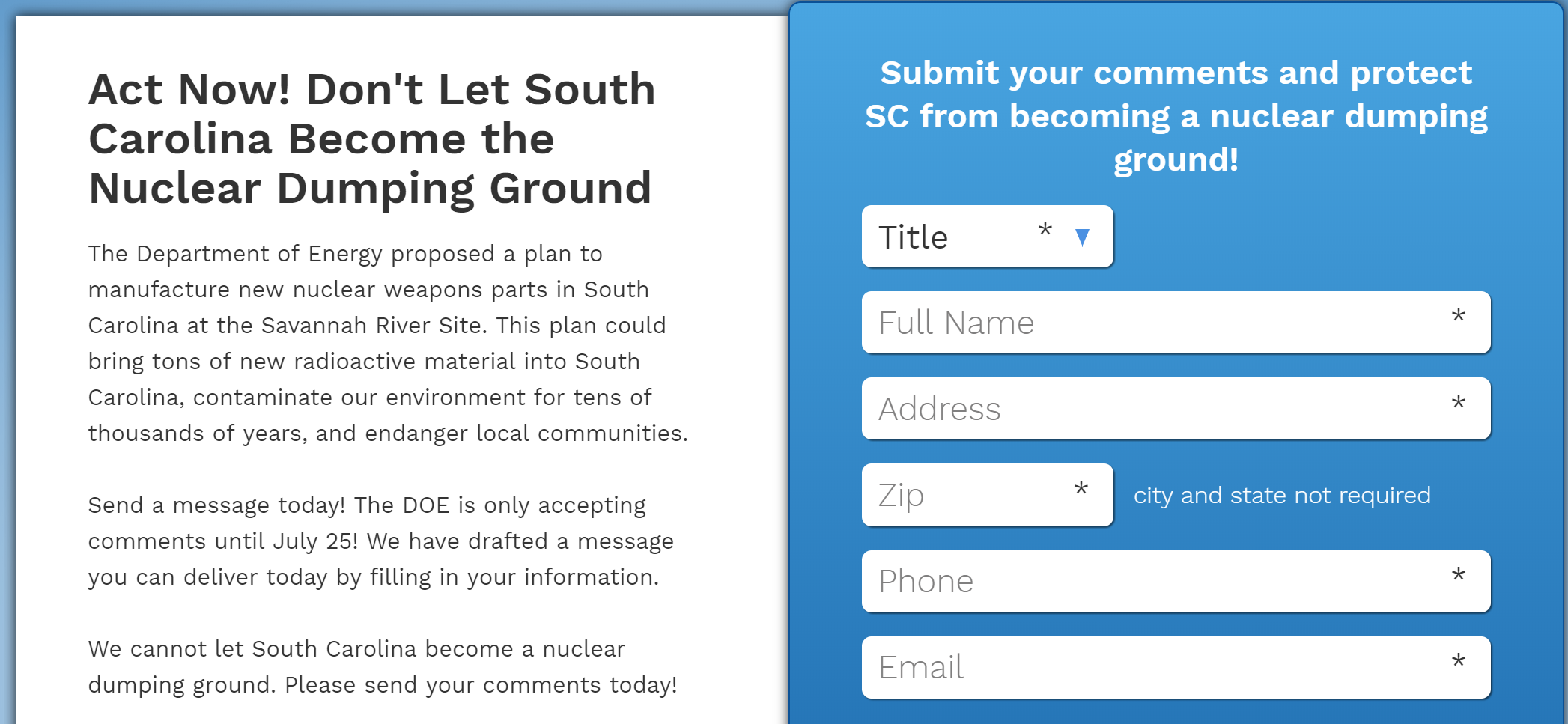
Listen and subscribe to Press the Button, a weekly podcast from Ploughshares Fund dedicated to nuclear policy and national security.
July 22 — This episode features Alex Wellerstein, historian of science at the Stevens Institute of Technology and creator of NUKEMAP – a website that allows you to simulate the effects of a nuclear weapons anywhere in the world. He talks in depth about the decision to drop the Bomb on Hiroshima and Nagasaki, on the effectiveness of nuclear deterrence, on the debate about the Bomb’s use after Trinity and much more.
Also featuring a guest appearance by WAND’s Caroline Dorminey.
Listen, Subscribe and Share on iTunes · Spotify · SoundCloud · Google Play
Also available on ploughshares.org/pressthebutton
In Budget Deal, White House And Congress Overpay For The Pentagon
The newly proposed two-year budget deal between the White House and Congress has one major flaw. It vastly overpays for the Pentagon.
At $738 billion for Fiscal Year 2020 and $740 billion for Fiscal Year 2021, the agreement sets the table for two of the highest budgets for the Pentagon and related work on nuclear warheads at the Department of Energy since World War II. The proposed figures are higher than spending at the height of the Vietnam and Korean Wars, and substantially more than the high point of the Reagan buildup of the 1980s. And the Fiscal Year 2020 and Fiscal Year 2021 numbers are only slightly less than spending in 2010, when the United States had 180,000 troops in Iraq and Afghanistan, roughly nine times the number currently deployed.
A Path Toward Renewing Arms Control
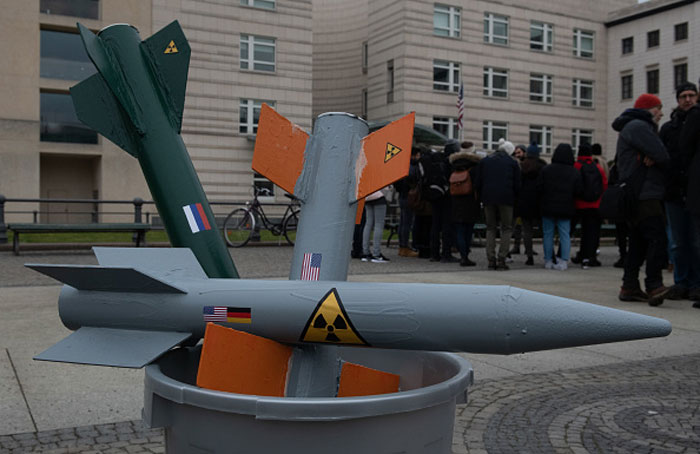
LAWRENCE J. KORB | thebulletin.org
At the late June G-20 meeting in Osaka, Japan, US President Trump and Russian President Putin met to discuss a number of issues, including Iran, Syria, Venezuela, Ukraine, and arms control. While all of these are important, none is more urgent at the current time than arms control because we are on the brink of a new arms race that could be an existential threat not only to these two nuclear super powers but to humanity.
Fewer Inspections for Aging Nuclear Plants, Regulators Propose
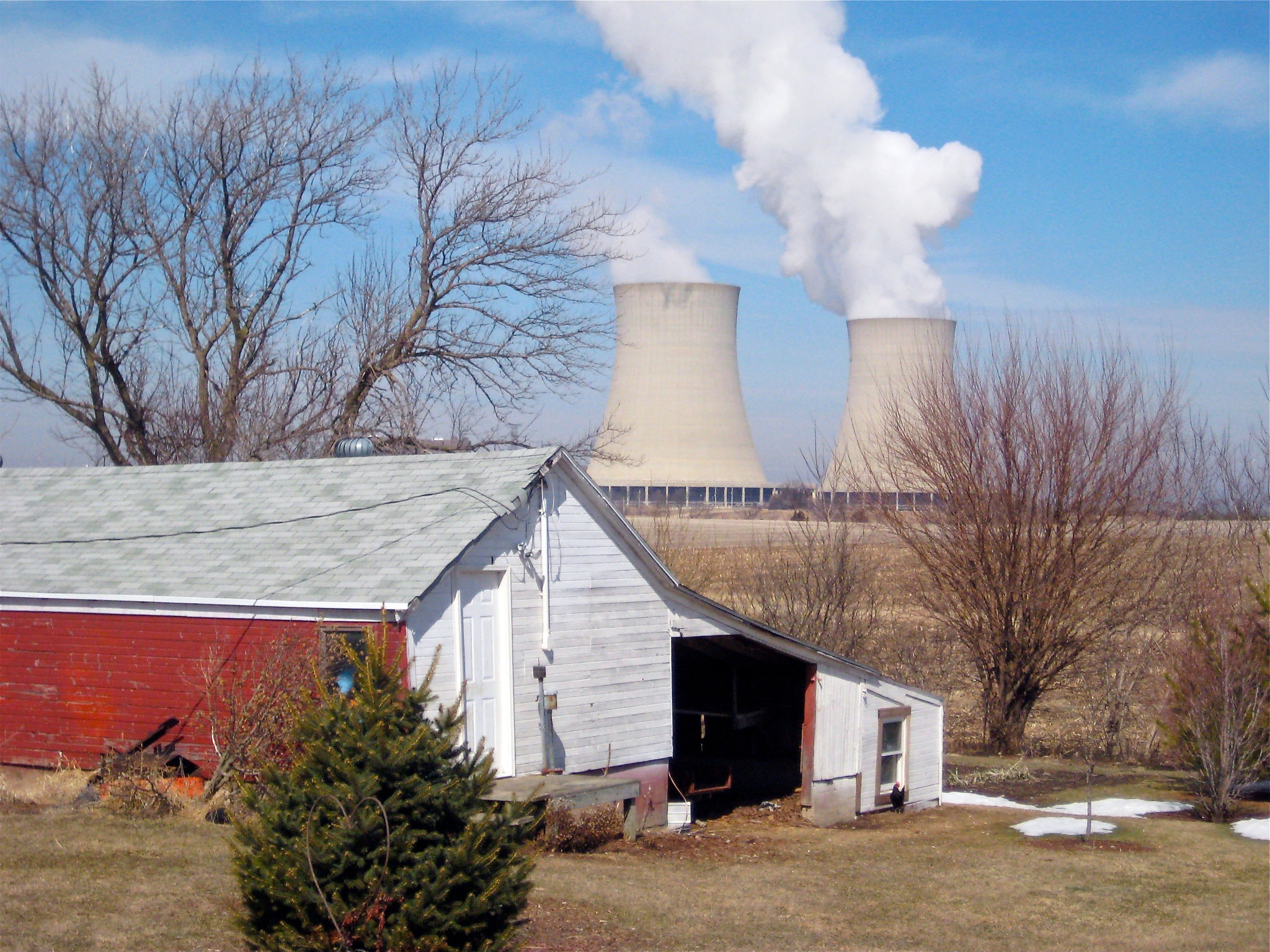
BY CORAL DAVENPORT | nytimes.com
WASHINGTON — A new report by staff members of the Nuclear Regulatory Commission, which oversees the safety of the nation’s 59 aging nuclear power plants, recommends that the commissioners significantly weaken or reduce safety inspections of the plants.
Edwin Lyman, the acting director of nuclear safety programs for the Union of Concerned Scientists, was highly critical of the proposal. “That’s bad because it could impair the ability of the N.R.C. to see larger patterns of violations at a plant,” he said, and called the proposal “a PR stunt. They’re doing it to make these things sound better.”
The report, published Tuesday, comes after a yearlong consultation and public meeting process, including views from the Nuclear Energy Institute, which lobbies on behalf of the nuclear power plant industry and has long sought weaker safety rules. It also comes amid a broader push by the Trump administration for reduced regulations on industry.
When Radioactive Wastes Aren’t Radioactive Wastes
With Congress Limiting What Can Be Dumped at Nuke Sites, the Energy Department May Just Redefine What It’s Dumping
JILLIAN S. AMBROZ. | dcreport.org
The U.S. Department of Energy wants to redefine what constitutes high-level radioactive waste, cutting corners on the disposal of some of the most dangerous and long-lasting waste byproduct on earth—reprocessed spent fuel from the nuclear defense program.
The agency announced in October 2018 plans for its reinterpretation of high-level radioactive waste (HLW), as defined in the Nuclear Waste Policy Act (NWPA) of 1982, with plans to classify waste by its hazard level and not its origin. By using the idea of a reinterpretation of a definition, the DOE may be able to circumvent Congressional oversight. And in its regulatory filing, the DOE, citing the NWPA and Atomic Energy Act of 1954, said it has the authority to “interpret” what materials are classified as high-level waste based on their radiological characteristics. That is not quite true, as Congress specifically defined high-level radioactive waste in the Nuclear Waste Policy Act, and any reinterpretation of that definition should trigger a Congressional response.
Lawmaker: Expand compensation from nuclear weapons testing
Original Article: apnews.com | BY SUSAN MONTOYA BRYAN
ALBUQUERQUE, N.M. (AP) — A compensation program for those exposed to radiation from years of nuclear weapons testing and uranium mining would be expanded under legislation that seeks to address fallout across the western United States, Guam and the Northern Mariana Islands.
U.S. Rep. Ben Ray Lujan rolled out the measure Tuesday on the 74th anniversary of the Trinity Test.
As part of the top-secret Manhattan Project, government scientists and the U.S. military dropped the first atomic bomb in the New Mexico desert in 1945. Nearly 200 atmospheric tests followed. Uranium mining persisted even after the tests ceased.
The Pentagon has more money than it can spend. Both Democrats and the GOP are to blame.
“To save taxpayer money and increase U.S. national security, the first step must be to reconceptualize U.S. strategy. That means abandoning the military-first approach that has governed U.S. security policy during this century.”
ARTICLE BY BEN FREEMAN & WILLIAM D. HARTUNG | newsweek.com
The bid from the Republican controlled Senate is $750 billion. The just passed bid from the Democratic controlled House is $733 billion. Both have radically overbid on the price of the Pentagon.
The real cost of the prize that is America’s security is significantly lower than what either party is currently bidding. As the Sustainable Defense Task Force—a group of ex-military officers, former White House and Congressional budget experts, and non-governmental analysts convened by the Center for International Policy which we co-chair—has found, America can be made more secure through less, not more, Pentagon spending. This is possible by rethinking U.S. defense strategy, taking a sober and fact-based assessment of the enormous amount of money already flowing to the Pentagon, and rigorously cutting waste and inefficiencies from the Pentagon bureaucracy.
Listen and subscribe to Press the Button, a weekly podcast from Ploughshares Fund dedicated to nuclear policy and national security.
July 15 — In this episode, Michelle Dover, Abigail Stowe-Thurston and Tom Collina deliver a wonderful, incisive news segment summarizing the major gains and debates in the NDAA (and how the Kardashians are getting involved in nuclear issues!).
Suzanne DiMaggio is featured delving deep into the dynamics of the crises with Iran and North Korea. Suzanne also presents her powerful rationale for the new Quincy Institute, where she is chair of the board.
“Looking at the catastrophic failures in foreign policy over the past decades, it is clearly time for something new,” Suzanne says, “The times demand it…We have to change the narrative in this town.”
Listen, Subscribe and Share on iTunes · Spotify · SoundCloud · Google Play
Also available on ploughshares.org/pressthebutton
Zakaria: The cancerous consensus in today’s politicized Washington
The United States’ defense budget is out of control, lacking strategic coherence, utterly mismanaged, ruinously wasteful and yet eternally expanding… “We never expected to pass [a financial audit],” admitted then-Deputy Defense Secretary Patrick Shanahan.
BY FAREED ZAKARAIA | trib.com
You often hear that in these polarized times, Republicans and Democrats are deadlocked on almost everything. But the real scandal is what both sides agree on. The best example of this might be the defense budget. Last week, the Democratic House, which Republicans say is filled with radicals, voted to appropriate $733 billion for 2020 defense spending. The Republicans are outraged because they — along with President Trump — want that number to be $750 billion. In other words, on the largest item of discretionary spending in the federal budget, accounting for more than half of the total, Democrats and Republicans are divided by 2.3 percent. That is the cancerous consensus in Washington today.
America’s defense budget is out of control, lacking strategic coherence, utterly mismanaged, ruinously wasteful and yet eternally expanding.
Lindsey Graham joins legal fight to restart SC nuclear fuel plant (MOX)
U.S. Sen. Lindsey Graham is urging the nation’s highest court to take up what appears to be South Carolina’s final push to resuscitate a shuttered nuclear facility at the Savannah River Site and bolster federal rules tied to plutonium processing and long-term storage.
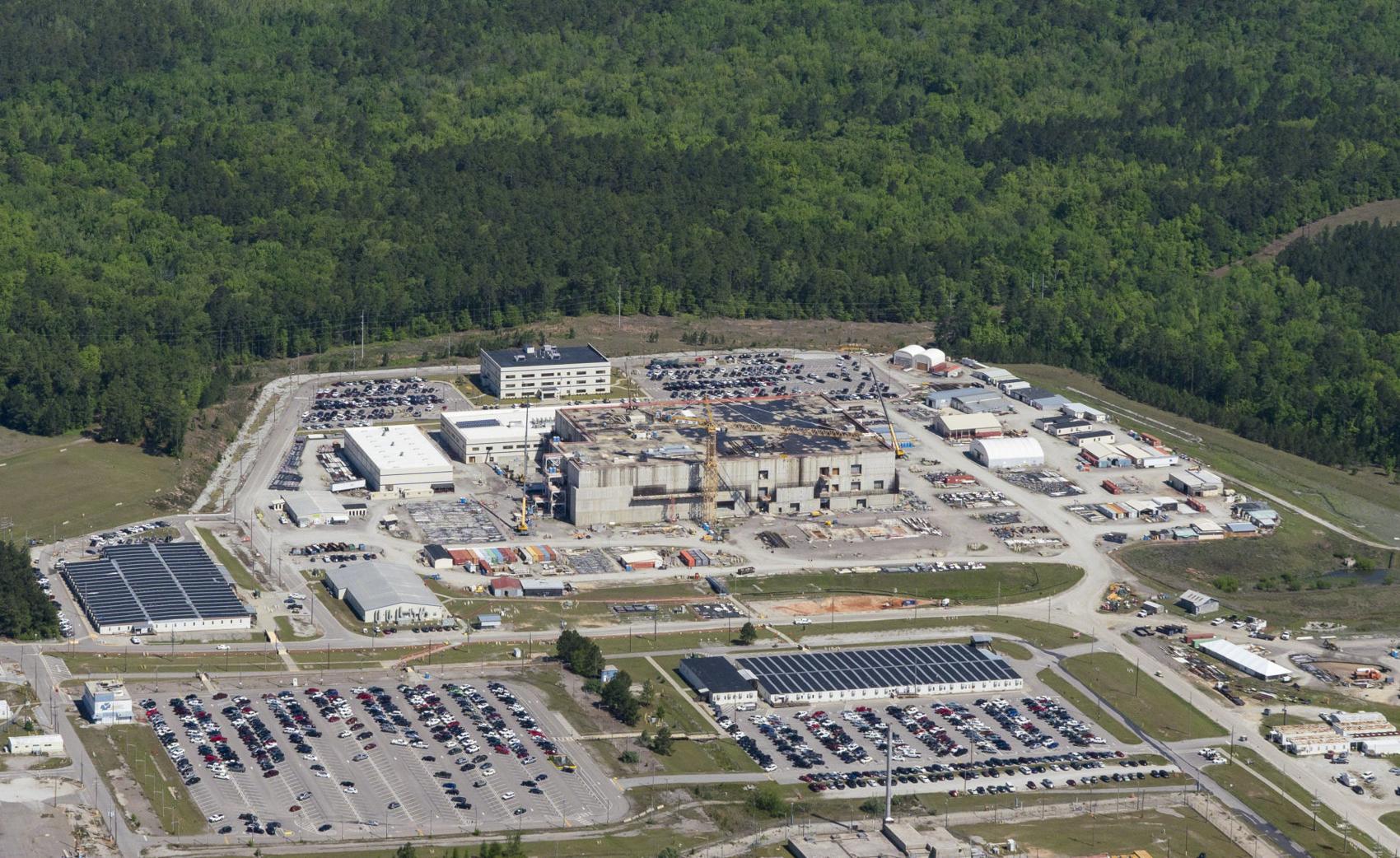
BY COLIN DEMAREST | postandcourier.com
Graham, a South Carolina Republican who chairs the Senate Judiciary Committee, argues that the federal government walked away from its obligation to address the plutonium stored in the Palmetto State. He addressed these concerns in a brief filed July 11 with the U.S. Supreme Court.
“The federal government previously made legally binding commitments to the state of South Carolina in recognition of its sovereign status and its proprietary interests,” Graham argued in the brief. “It has now breached those commitments, causing injury to the state that a court may redress.”
The brief describes Graham as “personally familiar” with the matters at hand and profoundly interested in the federal government’s promises to the state, which he was involved in negotiating.
Class Action Suit Draws Big Crowd – Portsmouth Gaseous Diffusion Plant
“DOE is simply not to be trusted. Period.”
— Carlos Williams speaking about local cancer concerns.
He has lived for thirty years five miles from the Portsmouth, Ohio uranium enrichment plant.
BY TOM CORRIGAN | PORTSMOUTH DAILY TIMES © 2019 Portsmouth Daily Times, all rights reserved.
Their stories were extremely varied. But many had one unfortunate commonality: cancer.

Larry and Janie Williams describe themselves as being fence line neighbors of the Portsmouth Gaseous Diffusion Plant since 1972. When she began to fall ill somewhat over four years ago, Larry said his wife’s doctor asked how she had come to be exposed to radiation. Janie never worked at the Portsmouth plant but spoke of daily hearing the ongoing construction of the decommissioned plant’s controversial on-site waste disposal facility. Janie said she developed a type of cancer that attacked her blood. Treatment included extremely expensive stem cell transplants. The transplants did buy her some time, though she added doctors gave her three to five years of life.
“I’m in year four,” said Janie, who clearly is accepting of her situation and spoke of her story unabashedly. She is 63.
Why SC is likely stuck with a stockpile of the nation’s most dangerous nuclear materials
POST & COURIER SPECIAL REPORT: LETHAL LEGACY
BY THAD MOORE & COLIN DEMAREST | postandcourier.com
South Carolina could be stuck with a massive stockpile of the nation’s most dangerous nuclear material for decades, despite a federal mandate and years of promises that the state wouldn’t become America’s plutonium dumping ground.
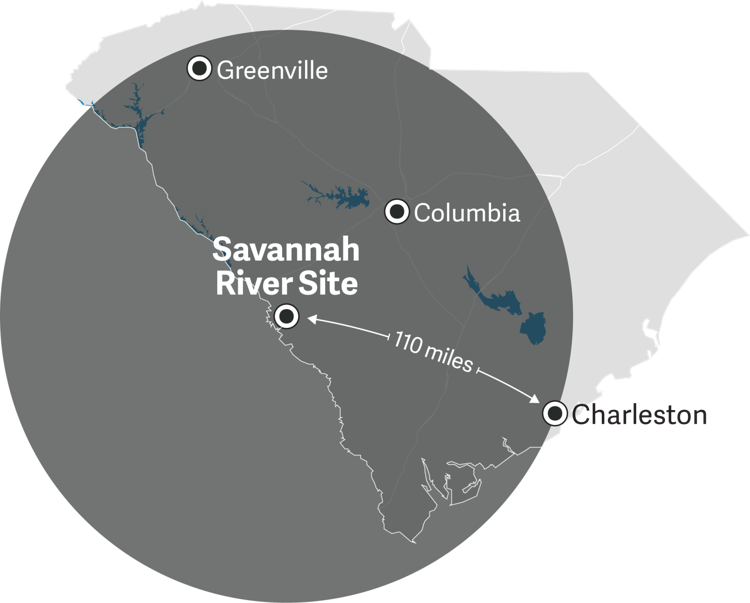 A restricted internal report obtained by the Aiken Standard and The Post and Courier suggests that the state is likely to become a long-term repository for enough plutonium to build the bomb dropped on Nagasaki nearly 2,000 times over.
A restricted internal report obtained by the Aiken Standard and The Post and Courier suggests that the state is likely to become a long-term repository for enough plutonium to build the bomb dropped on Nagasaki nearly 2,000 times over.
South Carolina faces this prospect despite a federal law that gives the U.S. Department of Energy just 2½ more years to remove its plutonium from the Savannah River Site, a huge swath of federal land along the Georgia border.
Hundreds gather in Piketon for town hall on alleged radioactive contamination
“[I] wanted to see what information is available,” Brandon Moore said. “What are we doing to help all these folks that are impacted or that may be impacted in the future?”
BY BRYANT SOMERVILLE. | 10tv.com
PIKETON, Ohio – People stood in line for hours, Tuesday, wanting to make sure they and their families were safe.
“I just want to make sure what’s going on if there was any contamination there or where we’re at,” Steve Copper said. “I want to make sure we got everything taken care of.”
“These materials are ounce-for-ounce the most dangerous materials known to man,” Stuart Smith said.
Smith is with Cooper Law Firm out of New Orleans. It was his firm that filed the lawsuit in May alleging Ohio residents near a former uranium enrichment plant in Piketon were exposed to radioactive contaminants that spread to other properties but were never informed.
Continue reading
Congress Introduces Legislation to Expand Compensation for Radiation Exposure
Luján, Members of Congress Introduce Legislation to Expand Compensation for Individuals Impacted by Radiation Exposure
Washington, D.C. – Today, Congressman Ben Ray Luján (D-N.M.), the U.S. House Assistant Speaker, introduced legislation to expand compensation for individuals exposed to radiation while working in and living near uranium mines or downwind from nuclear weapon test sites.
Tens of thousands of individuals, including miners, transporters, and other employees who worked directly in uranium mines, along with communities located near test sites for nuclear weapons, were exposed during the mid-1900s to dangerous radiation that has left communities struggling from cancer, birth defects, and other illnesses.

Trinity: “The most significant hazard of the entire Manhattan Project”
“New Mexico residents were neither warned before the 1945 Trinity blast, informed of health hazards afterward, nor evacuated before, during, or after the test. Exposure rates in public areas from the world’s first nuclear explosion were measured at levels 10,000- times higher than currently allowed.”
Final Report of the Los Alamos Historical Document and Retrieval and Assessment Project, Prepared for the Centers for Disease Control and Prevention, November 2010, pp. ES-34-35. VIEW HERE
Victims of the Trinity Test remain uncompensated, yet the Los Alamos Lab continues to expand plutonium pit production.
BY KATHLEEN M. TUCKER & ROBERT ALVAREZ | thebulletin.org
For the past several years, the controversy over radioactive fallout from the world’s first atomic bomb explosion in Alamogordo, New Mexico on July 16, 1945—code-named Trinity—has intensified. Evidence collected by the New Mexico health department but ignored for some 70 years shows an unusually high rate of infant mortality in New Mexico counties downwind from the explosion and raises a serious question whether or not the first victims of the first atomic explosion might have been American children. Even though the first scientifically credible warnings about the hazards of radioactive fallout from a nuclear explosion had been made by 1940, historical records indicate a fallout team was not established until less than a month before the Trinity test, a hasty effort motivated primarily by concern over legal liability.
Peace Activists Cut into Nuclear Weapons Base, Foiling Increased Security
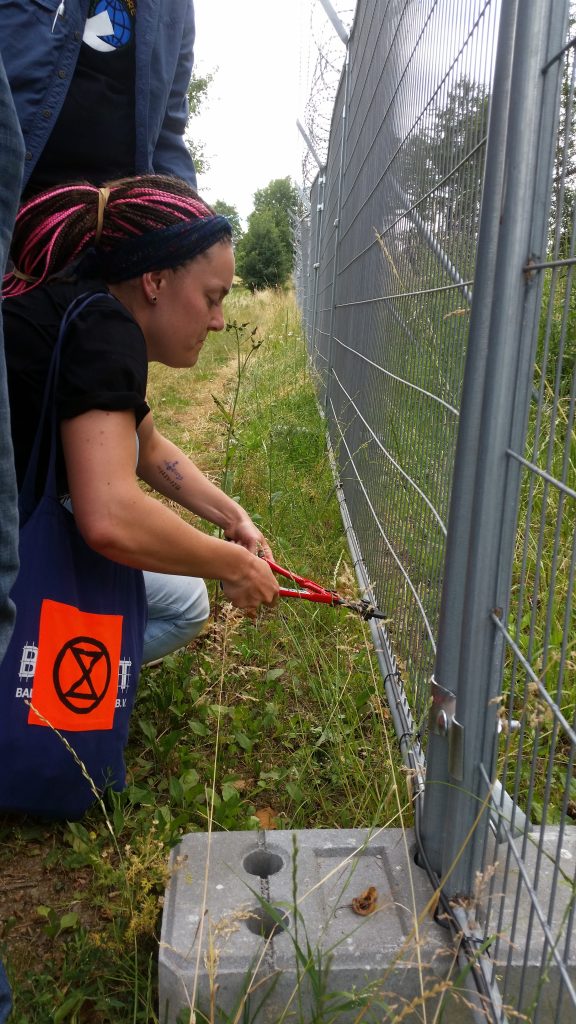
The Hoax That Nuclear Power is Green
This “Enviro Close-Up with Karl Grossman” demolishes the hoax that nuclear power is green. Continue reading
Wyoming lawmakers quietly explore storing spent nuclear fuel
Management Council votes by email to study housing spent nuclear fuel at Gas Hills, Shirley Basin to bring what a state senator says could be $1 billion a year.
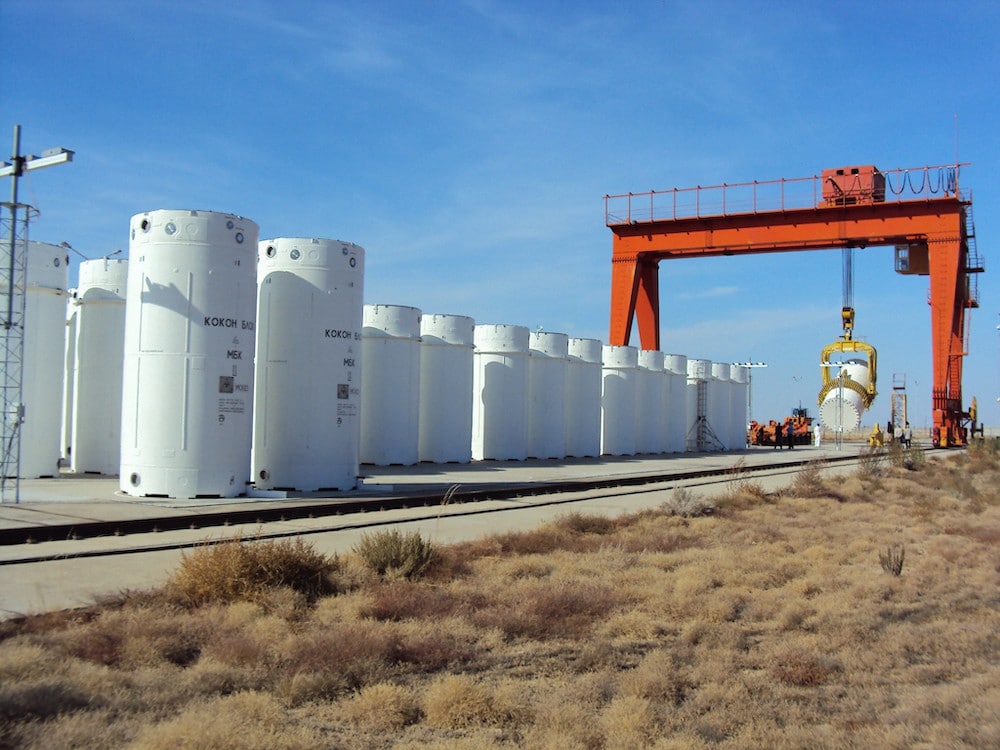
ANGUS M. THEURMER JR. | wyofile.com
A legislative committee has appointed six of its members to investigate the idea with the U.S. Department of Energy, Sen. Jim Anderson (R-Casper) told WyoFile on Friday. Anderson is co-chairman of the Joint Minerals Business and Economic Development Committee which received approval and funding from the Legislative Management Council in an unannounced vote to study the issue before the next legislative session begins in early 2020.
Wyoming’s dependence on an ailing coal industry spurred talk about pursuing the temporary storage idea, Anderson said. Fuel rods would be housed in casks with two-foot-thick walls, he said.
US suspends low-level radioactive waste shipments to Nevada
BY SCOTT SONNER | time.com
(RENO, Nev.) — A Nevada congressman called for U.S. Energy Secretary Rick Perry’s resignation Wednesday after the department acknowledged multiple shipments of low-level radioactive waste to a site north of Las Vegas may have been mislabeled and out of compliance with safety regulations for years.
The department had announced earlier that shipments of the waste from Tennessee to Nevada have been suspended while it investigates whether the materials were “potentially mischaracterized” as the wrong category of low-level waste. Low-level waste can include equipment or worker’s clothing contaminated by exposure to radiation, while mixed low-level waste can include toxic metals.
America’s Indefensible Defense Budget

BY JESSICA T. MATTHEWS | nybooks.com
The sheer size of the military establishment and the habit of equating spending on it with patriotism make both sound management and serious oversight of defense expenditures rare.
As a democracy, we are on an unusual and risky path.
For several decades, we have maintained an extraordinarily high level of defense spending with the support of both political parties and virtually all of the public. The annual debate about the next year’s military spending, underway now on Capitol Hill, no longer probes where real cuts might be made (as opposed to cuts in previously planned growth) but only asks how big the increase should be.
NMED won’t move LANL Oversight Bureau office from Los Alamos
“New Mexico Environment Department (NMED) Secretary James Kenney and other members of the department’s staff held a public meeting July 8 to address fears that NMED would move the Los Alamos National Lab (LANL) Oversight Bureau field office out of Los Alamos.
In June, the department announced a proposal to move the field office to a Santa Fe location. The news was met with immediate backlash from LANL watchdog groups such as Concerned Citizens for Nuclear Safety and Nuclear Watch New Mexico.”
By Kendra Chamberlain | nmpoliticalreport.com
The department held the meeting, the first of a series of public outreach events the department plans to hold this year throughout the state, in part to assuage public concerns around the future of the Oversight Bureau’s field office in Los Alamos.
In June, the department announced a proposal to move the field office to a Santa Fe location. The news was met with immediate backlash from LANL watchdog groups such as Concerned Citizens for Nuclear Safety and Nuclear Watch New Mexico.
Kenney, along with Resource Protection Division director Stephanie Stringer and Administrative Services Division director Michelle Desmond, explained some of the factors behind the contemplated move in a short presentation to audience members.
“[There] was never the intent to decrease oversight, or lessen any compliance or enforcement [over LANL],” Stringer told audience members.
“A lot of people [thought] when they heard we were moving off the hill, that it meant less oversight. There is no doubt in my mind that Secretary Kenney has made it my job to absolutely make sure compliance and enforcement and oversight of these facilities are top priority,” she said.
Iran’s Uranium Enrichment Breaks Nuclear Deal Limit. Here’s What That Means
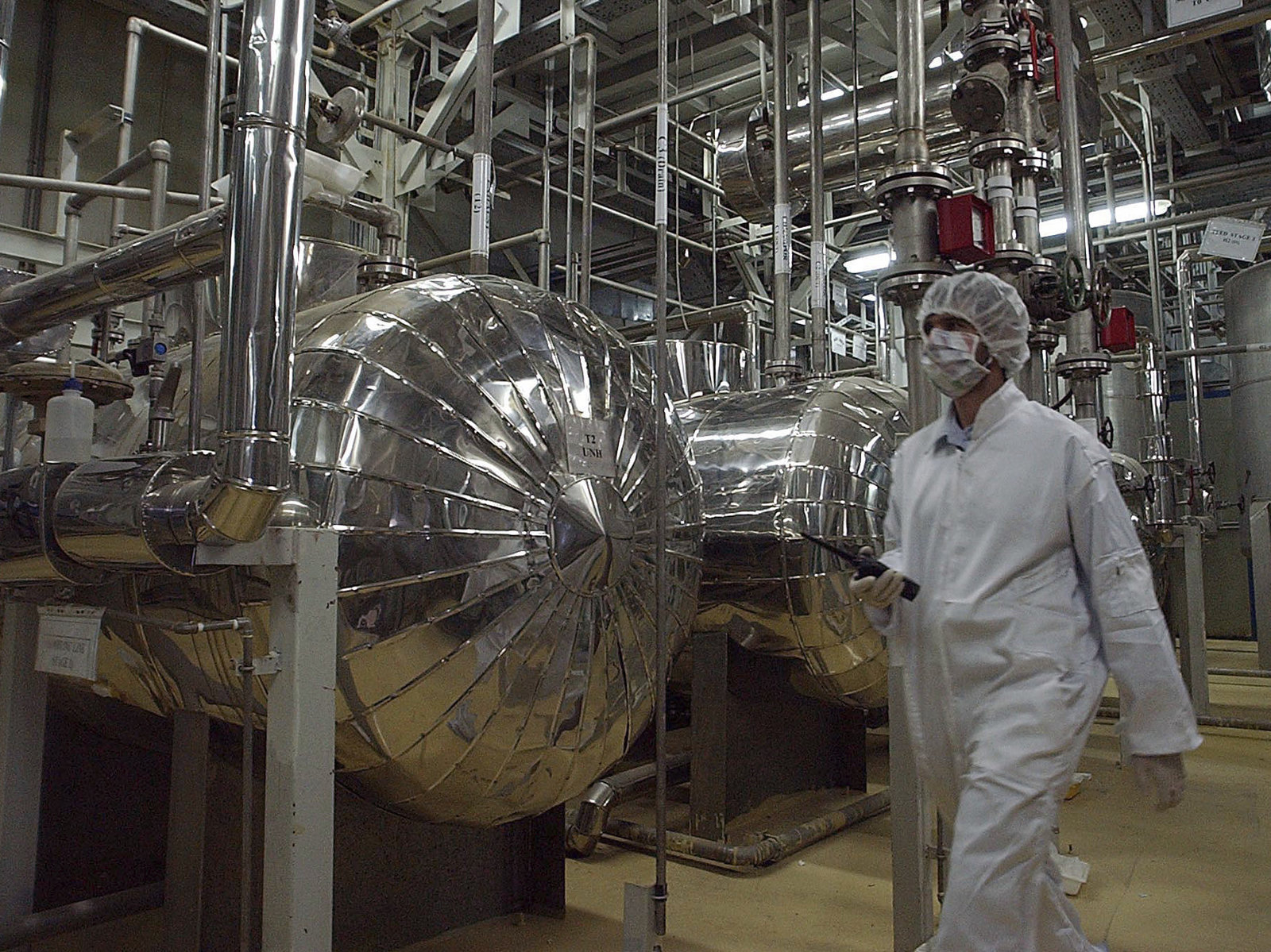
Vahid Salemi/AP
BY GEOFF BRUMFIEL | npr.org July 7, 2019
Iran has crossed another line set in the 2015 nuclear deal between it and major world powers.
According to state media, Iran has begun enriching uranium above levels enshrined in the agreement. The move sends a signal that Iran is losing patience with a deal that has not provided the economic relief promised, more than a year after the United States withdrew from the agreement.
By Monday, Iran had reached levels of around 4.5% enrichment, Behrouz Kamalvandi, the spokesman for the Atomic Energy Organization of Iran, told the semiofficial Fars news agency. He warned that Iran could go as high as 20% in the future, though that level is “not needed now.”
Inspectors from the International Atomic Energy Agency confirmed that Iran has crossed the line.
What public engagement?
This article was originally published July 6, 2019 in the Santa Fe New Mexican
Article Written by NukeWatch NM Volunteer: ALICIA SANDERS-ZAKRE
The Department of Energy’s new attempt at “enhanced public engagement” on legacy nuclear waste cleanup at Los Alamos National Laboratory failed both its stated objectives to consider public input and provide public education. To turn things around, officials should actually listen to public attendees and provide complete information at future meetings.
In the two-hour June 26 forum in Los Alamos, officials from the department’s Environmental Management Los Alamos Field Office, alongside N3B, the contractor tasked with implementing the cleanup, repeatedly proclaimed their interest in hearing from the public and pledged total transparency, but they didn’t give anyone in the packed room a chance to speak.
Renewables Catching Nuclear Power In Global Energy Race
Coal is still the dominant source of electricity around the world, although natural gas has taken over the top spot in the U.S. But, renewables have grown rapidly over the past decade, and are on the cusp of overtaking nuclear globally.
From 2007 to 2017, the Renewables category grew at an average annual rate of 16.4%. But within that category, power from geothermal and biomass grew at an annual average of 7.1%. Wind and solar power, by contrast, grew at an annual average of 20.8% and 50.2%, respectively, over the past decade.
In 2018, nuclear power was responsible for 2,701 Terawatt-hours (TWh) of electricity generation, compared to 4,193 TWh for hydropower and 2,480 for renewables.
Nuclear News Archives – 2018
New Mexico Senators Speak Out Over Order They Say Would Hamper Nuclear Safety Board
New Mexico Senators Speak Out Over Order They Say Would Hamper Nuclear Safety Board
They want Congress to suspend a move that would limit access to information about facilities and could hinder the panel’s ability to oversee worker health and safety.
by Rebecca Moss, Santa Fe New Mexican,
Aug. 31, 5 a.m. EDT
This article was produced in partnership with The Santa Fe New Mexican, which is a member of the ProPublica Local Reporting Network.
New Mexico’s senators are asking Congress to block a Department of Energy order that would limit a federal board’s access to information about nuclear facilities and could hinder its ability to oversee worker health and safety.
In a letter sent Wednesday to the leaders of a Senate appropriations subcommittee, Democratic Sens. Martin Heinrich and Tom Udall also asked their colleagues to block impending staff cuts and a broad reorganization at the Defense Nuclear Facilities Safety Board. New Mexico is home to three of the 14 nuclear facilities under the board’s jurisdiction: Los Alamos National Laboratory, Sandia National Laboratories and the Waste Isolation Pilot Plant.
“We feel strongly that these two matters facing the [safety board] and its future must be suspended while Congress and the public have time to review and offer constructive feedback” on how to maintain and improve the board, the senators wrote to Sens. Lamar Alexander, R-Tenn., and Dianne Feinstein, D-Calif., the chairman and ranking member of the energy and water development subcommittee.
The West’s atomic past, in opera halls
The West’s atomic past, in opera halls
On stage and in Congress, Trinity test downwinders fight for recognition.
Elena Saavedra Buckley, High Country News, Aug. 30, 2018
Outside the Santa Fe Opera, a 62-year-old venue nestled in juniper-covered hills, retirees reclined by cloth-covered tables in the parking lot. As the August heat reflected off the asphalt, they tailgated with flutes of champagne. Soon, they would file in to see Doctor Atomic, an opera about physicist J. Robert Oppenheimer and the 24 hours before the first atomic bomb, which he helped create, detonated over New Mexico’s Tularosa Basin in the Trinity test.
Doctor Atomic has been performed in New York and San Francisco, but never before in New Mexico, where Manhattan Project scientists from Los Alamos Laboratory created the bomb. John Adams composed the opera in 2005, and Peter Sellars’s libretto uses declassified Los Alamos documents, focusing on the scientists’ perspective. This was the first time that downwinders — people whose families lived in the Tularosa Basin, in the path of the bomb’s radiation — appeared on stage during a performance. This summer, 73 years after Trinity, New Mexico’s downwinders are finally receiving some attention — onstage and in Congress.
The Trinity test occurred at 5:30 a.m. on July 16, 1945, about 150 miles south of Santa Fe and the laboratory and only weeks before the bombings in Japan. It bathed the basin in light, creating a half-mile-wide crater. The Tularosa Basin Downwinders believe that blast’s radiation gave their families cancer, either from the air or through milk and produce, and that the diseases are being passed down genetically.
Trump Administration Muzzles Nuclear Weapons Safety Watchdog
Trump Administration Muzzles Nuclear Weapons Safety Watchdog
The administration, working in open alliance with profit-making contractors, is scaling back the safety group’s authority and slashing its staff.
Center For Public Integrity
08.30.18 6:00 AM ET
By Patrick Malone, Center for Public Integrity
A small government safety organization tasked with protecting the workers who construct America’s nuclear arsenal and with preventing radioactive disasters in the communities where they live is under new siege in Washington.
The Trump administration, acting in an open partnership with the profit-making contractors that control the industrial sites where U.S. nuclear bombs are made and stored, has enacted new rules that limit the authority and reach of the Defense Nuclear Facilities Safety Board, created by Congress in 1988 amid broad public concerns over civil and military nuclear safety lapses.
The administration’s new rules eliminate the board’s authority to oversee workplace protections for roughly 39,000 nuclear workers and also block its unfettered access to nearly three-quarters of the nuclear weapons-related sites that it can now inspect.
In a separate move, the board’s new acting Republican chairman has proposed to put more inspectors in the field but to cut its overall staff by nearly a third, including letting some of its supporting technical experts in Washington go. The board already has one of the smallest oversight staffs of any federal agency.
The twin assaults on the operations and authority of the safety board come just as the Energy Department, acting at President Trump’s direction, is embarking on the most aggressive era of nuclear weapons production since the Cold War. Trump has called for one new nuclear bomb to be produced immediately and for the production of another new bomb to be studied.
A Nuclear Energy Meltdown Scrambles Southern Politics
A Nuclear Energy Meltdown Scrambles Southern Politics
South Carolinians have some of the highest electricity bills in the country, thanks in part to nuclear energy
BY ANDREA COOPER | AUG 30 2018
REVEREND LEO WOODBERRY CLUTCHED the pulpit, his voice rumbling toward the people gathered in the basement theater at Little Rock AME Zion church. Around 75 men and women wearing everything from stylish dresses to blue jeans and T-shirts sat in rapt attention.
“Talk to your friends,” Woodberry implored, wearing a “Justice First” T-shirt and a baseball hat. “Your neighbors, your commissioners, your mayors. Tell them we are ready right now to move away from fossil fuels. We’re ready to make our cities 100 percent renewable!”
People clapped, whistled, and cheered “Yes!” and “Amen!”
Woodberry was on his Justice First Tour in Charlotte, North Carolina, 100 miles from his home in Florence, South Carolina. The environmental activist had come here to proclaim that the moment had arrived for the climate change, women’s rights, immigrants’ rights, criminal justice reform, and marriage equality movements to unite for a common cause: opposing an extractive economy “based on death and destruction and sickness.”
That same economy is responsible for an unprecedented energy and financial disaster in Woodberry’s home state: A $9 billion nuclear project—once heralded as part of a U.S. nuclear revival—has been abandoned after years of delays and mismanagement. One of the South Carolina utilities responsible for the colossal failure has billed its customers $37 million each month to recoup costs.
A Salute to Whistleblowers – Mark your calendar! Sept. 25 at 7pm at CCA
|
The US Government Is Updating Its Nuclear Disaster Plans And They Are Truly Terrifying
The US Government Is Updating Its Nuclear Disaster Plans And They Are Truly Terrifying
“We are looking at 100 kiloton to 1,000 kiloton detonations,” a FEMA official said.
Dan Vergano BuzzFeed News Reporter
Reporting From Washington, DC
Posted on August 24, 2018, at 11:59 a.m. ET
Amid concerns over North Korea, federal emergency managers are updating disaster plans to account for large nuclear detonations over the 60 largest US cities, according to a US Federal Emergency Management Agency official.
The shift away from planning for small nuclear devices that could be deployed by terrorists toward thermonuclear blasts arranged by “state actors” was discussed on Thursday at a two-day National Academies of Sciences workshop for public health and emergency response officials held at its headquarters across the street from the US State Department.
“We are looking at 100 kiloton to 1,000 kiloton detonations,” chief of FEMA’s chemical, biological, radiological, and nuclear branch Luis Garcia told BuzzFeed News. The agency’s current “nuclear detonation” guidance for emergency planners, first released in 2010, had looked at 1 to 10 kiloton blasts — smaller than the 1945 Hiroshima and Nagasaki atomic bombs that killed more than 200,000 people at the end of World War II. Those smaller size detonations had seemed more reasonable after 9/11, with high concerns about an improvised terrorist bomb.
CALIFORNIA LEADS THE WAY IN SUPPORT OF NUCLEAR DISARMAMENT
California State Legislature Passes Pro-Nuclear Disarmament Resolution
Sacramento–Assembly Joint Resolution 33 (AJR 33), introduced by Santa Barbara’s State Assembly member, Monique Limón, passed in the state Senate today by a vote of 22 to 8. This marks a huge step forward in California’s support of nuclear disarmament and puts the state at the forefront of this critical issue.
The resolution calls on federal leaders and our nation to embrace the Treaty on the Prohibition of Nuclear Weapons, make nuclear disarmament the centerpiece of our national security policy, and spearhead a global effort to prevent nuclear war. (More on the Treaty here.)
Rick Wayman, Deputy Director of the Nuclear Age Peace Foundation, a non-partisan, non-profit organization headquartered in Santa Barbara whose mission is to create a peaceful world, free of nuclear weapons, was asked by Limón to testify in support of the Resolution.
The modern nuclear arsenal: A nuclear weapons expert describes a new kind of Cold War
The modern nuclear arsenal: A nuclear weapons expert describes a new kind of Cold War
Nuclear Knowledge: The modern nuclear arsenal
https://www.washingtonpost.com/video/politics/nuclear-knowledge-the-modern-nuclear-arsenal/2018/08/20/9d370fec-a0b8-11e8-a3dd-2a1991f075d5_video.html
Secrecy, bombastic threats and doomsday talk abound when talking about nuclear weapons, so The Post sat down with expert Hans Kristensen to clear the air. (Jenny Starrs /The Washington Post)
By Jenny Starrs
August 24 at 7:00 AM
With the flurry of talks with North Korea and the fallout from the U.S. withdrawal from the Iran nuclear deal, nuclear weapons have become a major topic of discussion in recent months. But secrecy abounds: Who has what weapons? How many? How much damage could they do?
Hans Kristensen tries to answer those questions. As the director of the Nuclear Information Project at the Federation of American Scientists, Kristensen and his colleagues delve into open source data, analyze satellite imagery and file requests under the Freedom of Information Act to get the most accurate picture of the world’s nuclear-armed countries. The initiative produces reports on nuclear weapons, arms control and other nuclear matters, and gives recommendations on how to reduce the role and number of nuclear weapons worldwide.
Kristensen sat down with The Washington Post to discuss how the United States’s nuclear capabilities stack up with the rest of the world, and potential problems down the road. The questions and answers have been edited for brevity.
New Los Alamos lab manager Triad will pay Gross Receipts Tax
New Los Alamos lab manager Triad will pay GRT, official says
By Andy Stiny | astiny@sfnewmexican.com
Aug 22, 2018 Updated 16 hrs ago
A representative of Triad National Security LLC, which takes over management of Los Alamos National Laboratory in November, said Wednesday the consortium will pay gross receipts taxes, easing concerns of local officials about losing millions of dollars in revenue.
Scott Sudduth, assistant vice chancellor with the Office of Federal Relations for the Texas A&M University system, told an audience of about 50 community members during a meeting in Los Alamos that the New Mexico Taxation and Revenue Department responded to a recent inquiry from Triad by saying that “it is their view that the gross receipts tax does apply to Triad.”
Los Alamos County officials had said previously that if Triad were deemed to have nonprofit status, the county estimated it could lose $21 million annually and the state $23 million in gross receipts tax revenues, according to published reports.
State could block proposed nuclear storage site near Carlsbad
State could block nuclear storage site near Carlsbad even if federally licensed
By Adrian C. Hedden / Carlsbad Current-Argus, N.M. (TNS)
State lawmakers maintained they will have a say in a proposed facility to store high-level nuclear waste near Carlsbad and Hobbs, despite an opinion issued by New Mexico Attorney General Hector Balderas suggesting New Mexico will have a limited role in licensing the project.
New Mexico Sen. Jeff Steinborn (D-36), who chairs the New Mexico Radioactive and Hazardous Waste Committee said Balderas’ opinion was informative but did not preclude lawmakers from preventing the facility from operating.
The committee convened in May to study the project proposed by New Jersey-based Holtec International, and held its third meeting on Wednesday at University of New Mexico-Los Alamos.
Opposed to the project, Steinborn said state lawmakers owe their constituents a full review of the proposal.
“I think it’s kind of a troubling deficiency in the government if the state doesn’t have to give consent to have something like this foisted upon it,” he said. “The State of New Mexico owes it to the people to look at every aspect of it.”























